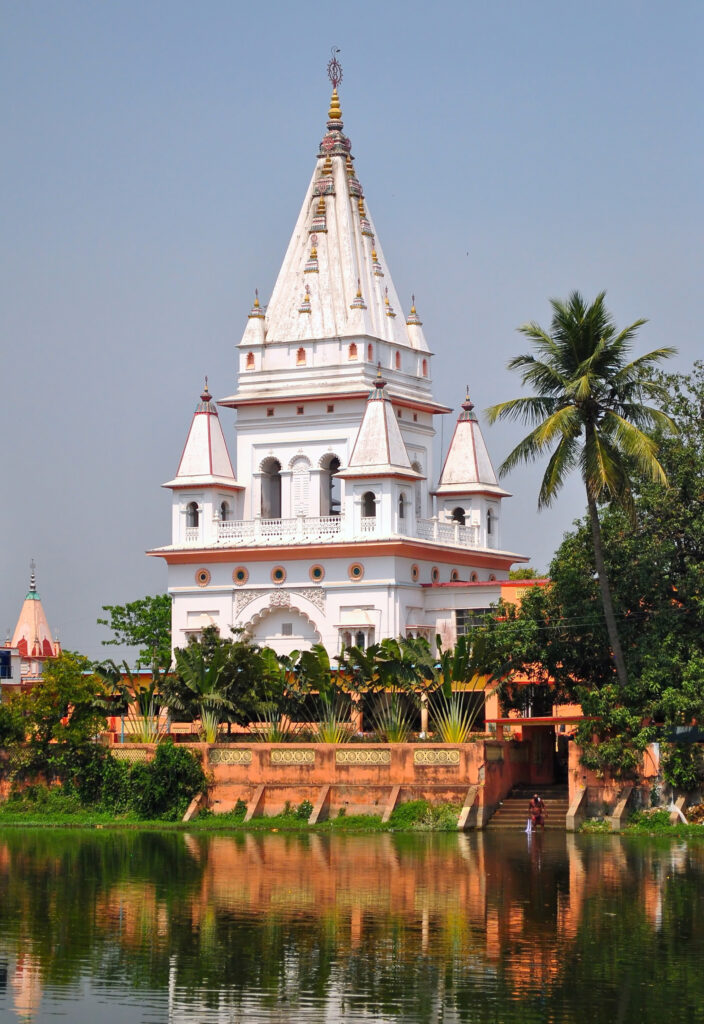
After the discovery of the birthplace of Lord Chaitanya, Srila Bhaktivinoda Thakur was blessed with the holy association of Srila Jagannath Das Babaji Maharaja. The two great Vaisnavas spent some time together worshiping the Lord at the Yogapitha at Mayapur. Srila Bhaktivinoda Thakur’s son, Lalita Prasad, relates that one of the Thakur’s sons was suffering from a skin disease at that time, and that Srila Babaji Maharaja told him to lie down in the dust at the site of the Lord’s birth. The boy did so, and was cured by the next day.
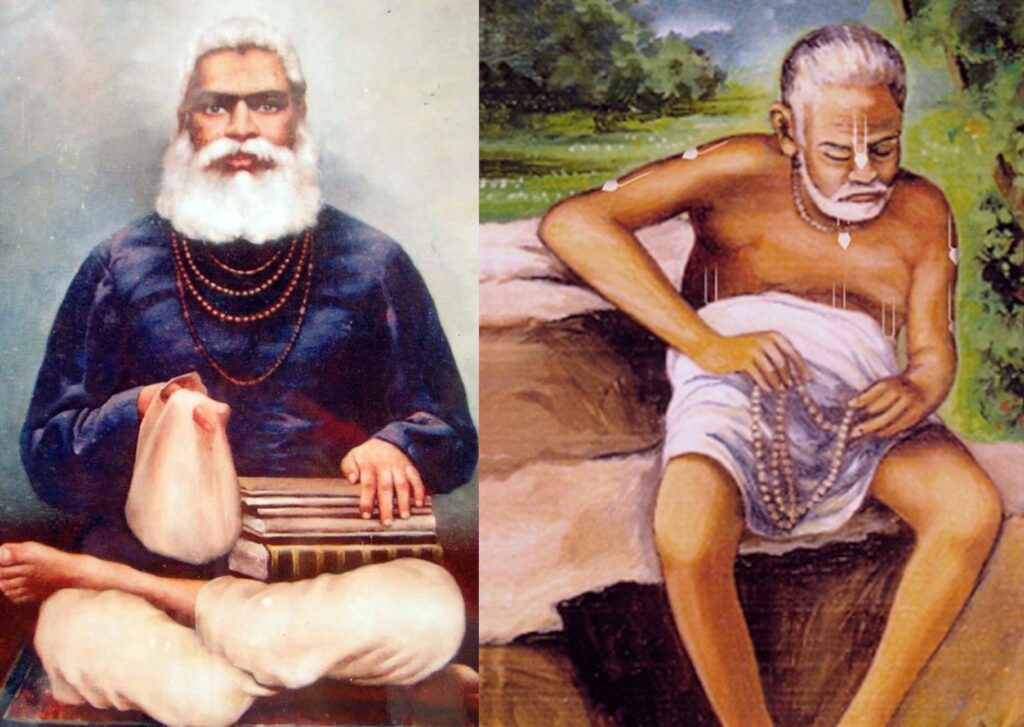
Later, when Jagannath Das Babaji returned to his place of bhajan at Kuliya [Koladvipa], he requested Srila Bhaktivinoda Thakur, who was eager to render some service to him, to build a solid covered veranda, so that the Vaisnavas who came to see him would have a pleasant place to sit and chant. The Thakur immediately complied with that order, to his guru’s full satisfaction. Jagannath Das Babaji’s bhajan kutira with the veranda added by Bhaktivinoda Thakur can be seen today at Koladvipa, one of the nine “islands” of Navadvipa. Sometimes referred to as Kuliya, Koladvipa is situated on the western side of the Ganges.
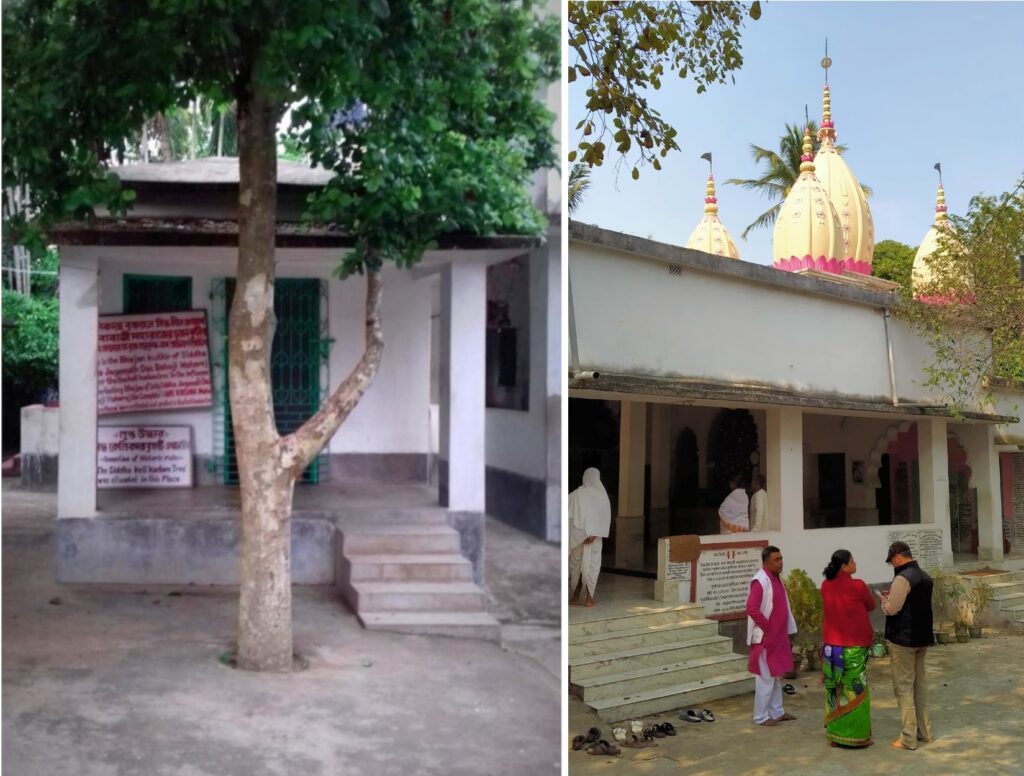
Bhajan Kutira and Samadhi of Jagannath Das Babaji
Returning to Krishnanagar, the Thakur’s health deteriorated. He was afflicted with severe tonsillitis. He received two month’s leave, and during that time he purchased the place where he would write many books and perform hours of bhajana: Sri Surabhi-kunja.
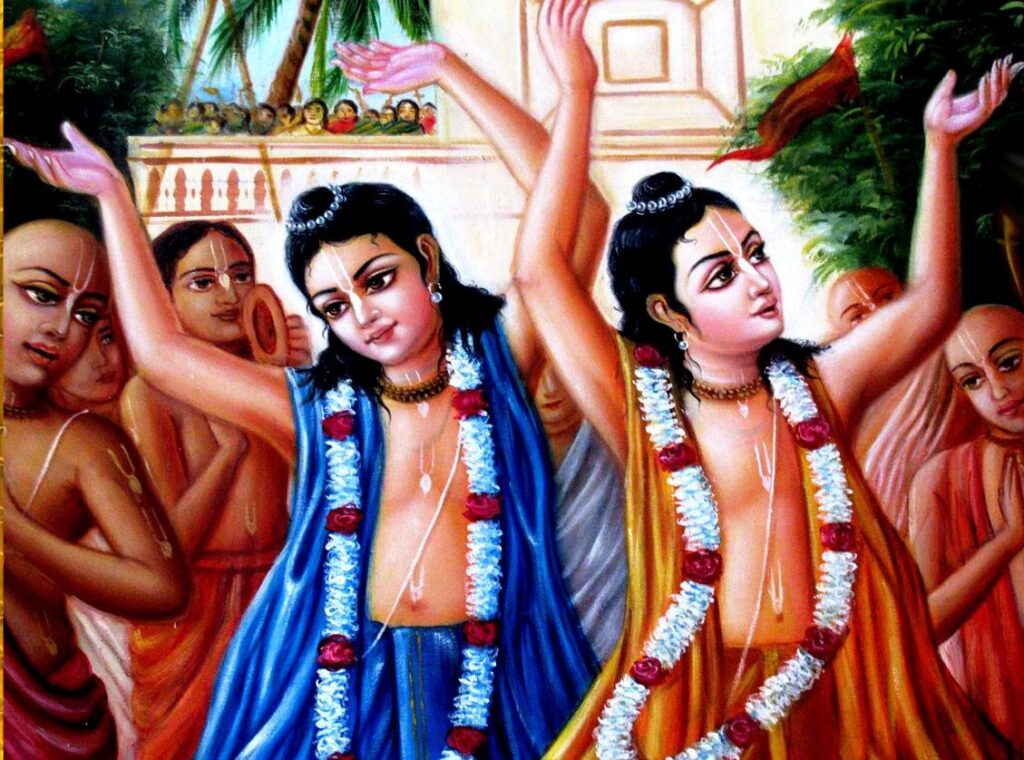
Surabhi-kunja, situated in Godrumadvipa, is the place where Lord Nityananda started His Nama-hatta – “The Marketplace of the Holy Name.” Lord Nityananda’s original Nama-hatta spread all over Bengal in due course. In later years Srila Bhaktivinoda Thakur reignited the Nama-hatta, while doing his bhajan at Godrumadvipa.
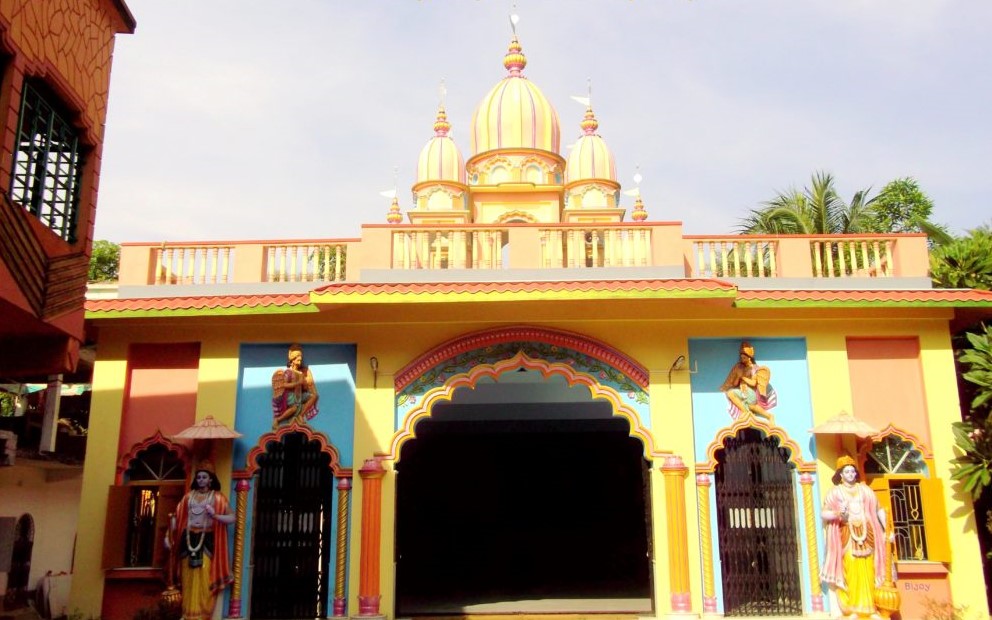
Sri Surabhi Kunja in Godrumadvipa, Mayapur
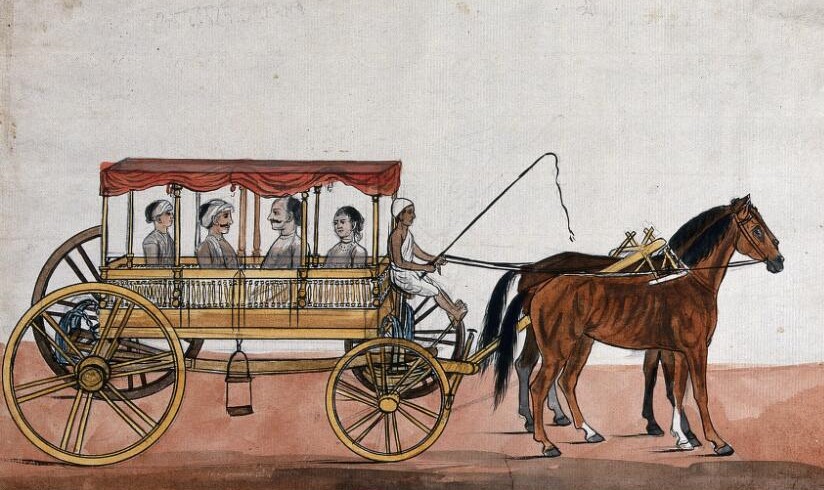
He then travelled with his family by horse and carriage and visited Ulagram, the place of his birth and childhood. After visiting his boyhood home, he spoke to the government officer, Mr. Edgar, who had helped him get a post in Krishnanagar, about transferring to a place where he could regain his health. In 1889 Srila Bhaktivinoda Thakur moved to Netrakona, from there to Tangail and from Tangail to Burdwan.
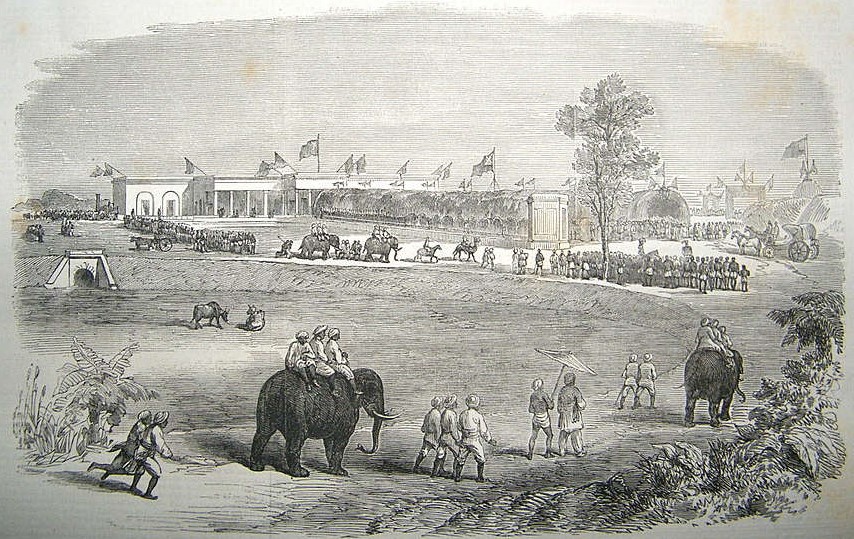
Burdwan
During his stay in Burdwan, the Thakur sometimes suffered from fevers and had difficulty breathing. When he recovered, he resumed his duties. While in Burdwan he performed kirtan with the Vaisnavas of Amalajora, headed by Ksetra and Vipina Babus and noted their strong devotion to Sri Chaitanya Mahaprabhu. The Thakur composed poems like Soka-satana, which described in thirteen songs the disappearance of Sri Srivasa’s son during Lord Chaitanya’s kirtan, and his friends would sing them. All the while he was working on his books, despite all difficulties.
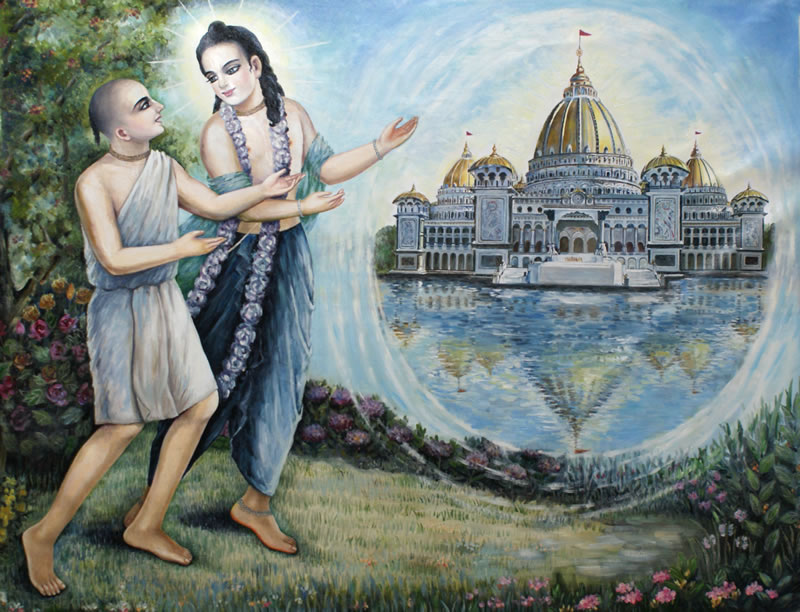
Sri Navadvipa-dhama-mahatmyam
1890 saw the publication of Amnaya-sutram, a work comprised of 130 Sanskrit sutras describing the Absolute Truth, with his commentary, Laghu-bhasya, together with Bengali translations of the codes. He also published the Sri Navadvipa-dhama-mahatmyam, which comprised eighteen chapters written in Bengali verse describing Jiva Gosvami’s tour of the land of Navadvipa in the company of Lord Nityananda. This was called the Parikrama-khanda. A second volume of this work called Pramana-khanda was also published. This was a collection of Sanskrit verses glorifying the holy land of Navadvipa, gathered by him from the Vedic literature and arranged in five chapters.
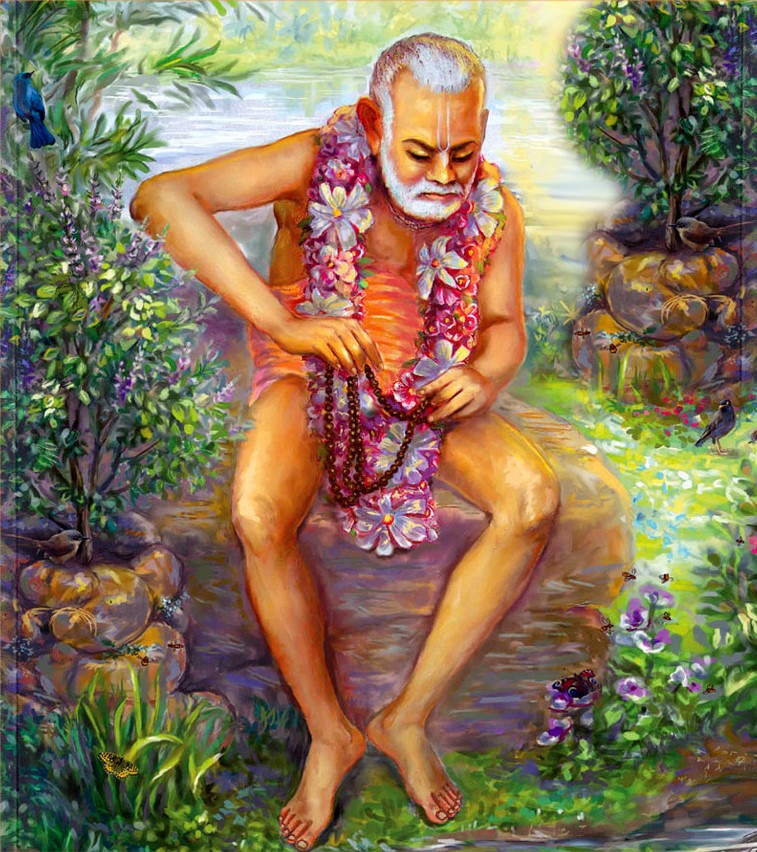
In March and April of 1890 he got the chance to tour various holy places, including the birthplace of Vrindavan Das Thakur, author of the Chaitanya Bhagavat. On May 19th he took darsana of Srila Jagannath das Babaji in Kuliya with great delight. From Burdwan he was transferred briefly to Raniganj and then back again to Dinajpur in 1891. In 1891 he published his Bhagavad-gita with the Sanskrit commentary of Srila Baladeva Vidyabhusana called Gita-bhusana, as well as his own Bengali commentary, Vidvad-ranjana.
Preaching the Holy Name
In August of 1891, the Thakur received approval for a two-year furlough. He wanted to preach the glories of the Holy Name for the benefit of humanity. His base for this preaching effort was Godrumadvipa, which the Thakur dubbed the Nama-hatta, ‘the Market Place of the Holy Name.’ He travelled with Sri Ramsevak Chattopadhyaya Bhaktibhrnga, his old friend, as well as Sri Sitanath Das Mahapatra and Sri Sital Bhrtya. They chanted in many places, gave lectures and made devotees.
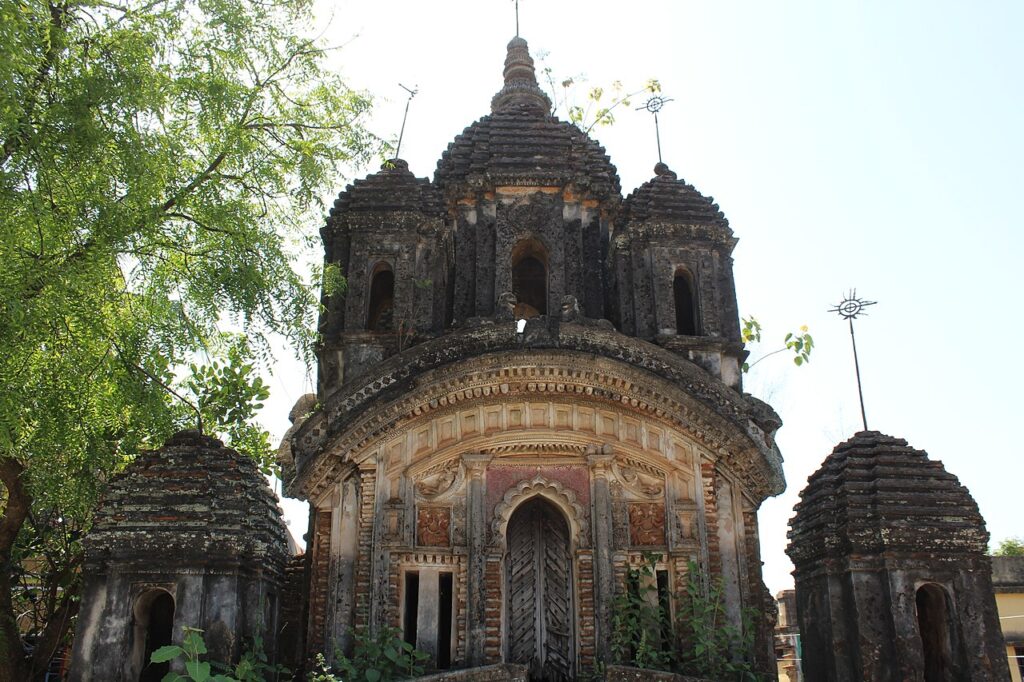
Damodar Temple at Ramjivanpur
The Thakur describes this period with happiness:
At this time in the month of Avin, Ramsevak Babu, Sita Nath and Sital Bhritya all took a ship to Ramjivanpur for chanting and lectures … In many places in Ramjivanpur we chanted and spoke, and we were very happy. From there, we went to Kayapath Badanganja, where we lectured. In that place all of the devotees, brahmanas and panditas were pleased. Having stayed thirteen days in that area, and concluding with a lecture program in Ghatal, we returned. We performed nama-sankirtan everywhere. After coming to my house in Calcutta, I proceeded to Surabhi-kunja and we performed a great deal of sankirtan there too.
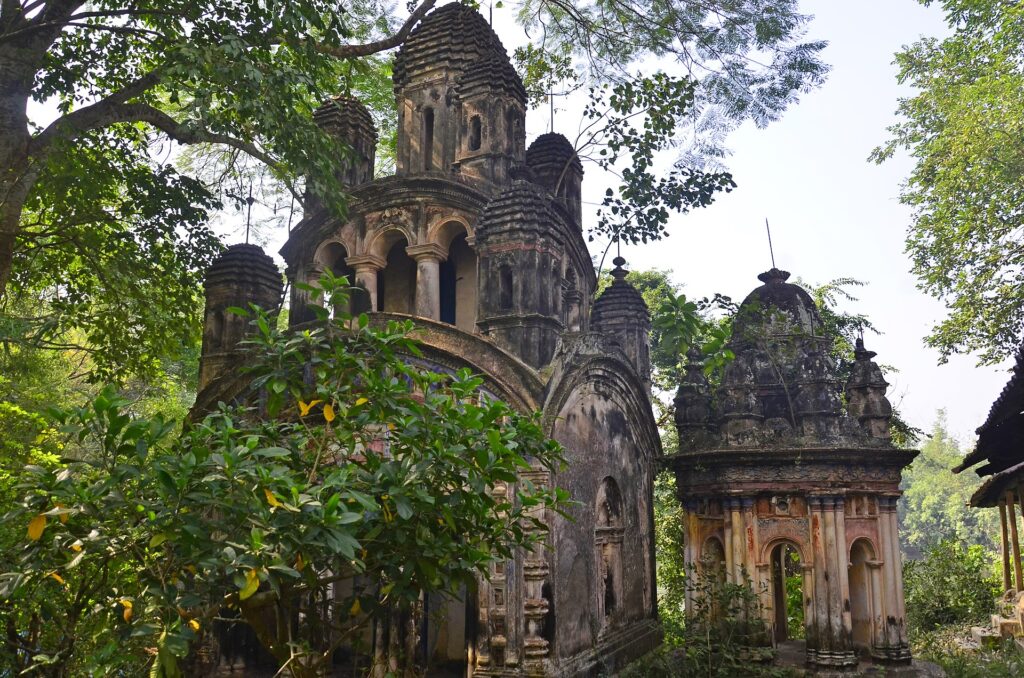
Ghatal
In his lifetime, the Thakur established over five-hundred Nama-hatta sarigas (associations), and in his original Nama-hatta essay entitled, Sri Sri Godruma-kalpatavi, he describes the structure of the Nama-hatta. The spirit of his endeavor exactly matched the mood of Lord Nityananda, Who was personally ordered by Sri Chaitanya Mahaprabhu to preach in Bengal. Lord Chaitanya directed Him thus:
suno suno nityananda, suno haridasa, sarvatra amara ajna koroha prakasa, prati ghare ghare giya koro ei bhiksa, bolo krsna, bhaja krsna, koro krsna siksa
O hear Me, hear Me Nityananda! Hear Me Haridasa! Simply disseminate My order everywhere. Go from house to house and beg [the residents as follows]: ‘Speak about Krishna, worship Krishna and teach [others] about Krishna.’
[Caitanya-bhagavata Madhya-llla 13:8-9]
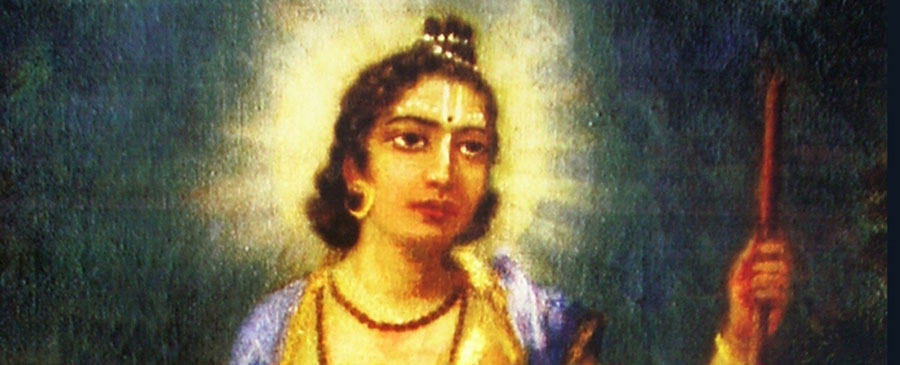
In his Nama-hatta essay the Thakur always describes himself as the sweeper of the market-place of the Holy Name. In that market-place in Godrumadvipa, the storehouse is the Srimad-Bhagavatam, and the principal trader is Sri Nityananda Prabhu. The co-principal trader in Bengal is Sri Advaita Prabhu; in Vrindavan, Rupa and Sanatan Gosvamis; in Jagannath Puri, Sri Svarupa Damodar and Ramananda Raya. The store-keepers in Bengal are Sri Gadadhar Pandit, Srimati Visnupriya and Srimati Jahnava Thakurani, Lord Nityananda’s wife; in Vrindavan, Raghunath Das Gosvami; in Jagannath Puri, Sri Paramananda Puri. Following this explanation is a description of the transcendental currency of the market: the various levels of devotion are compared to paisa (the smallest denomination), to annas (an anna equals about six paisa) and to silver coins, and prema (pure love of God) to the most valuable denomination, the gold coin.
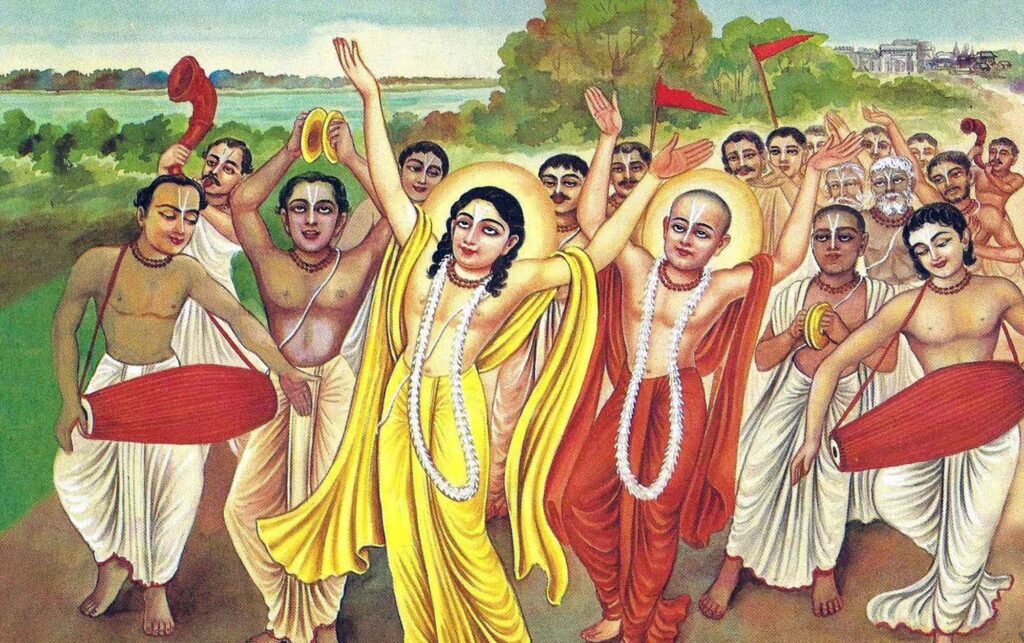
Description of the Transcendental Currency
Sraddha (faith) is compared to a paisa (a small coin worth only 2-5 cents) by which the Holy Name can be be purchased.
Nistha (steady devotional service) is compared to two annas or a 1/8 silver coin by which the Holy Name imbued with the Lord’s form (rupa-yukta-nama) can be purchased.
Ruci (taste) is compared to four annas or a 1/4 silver coin by which the Holy Name imbued with the Lord’s qualities (guna-yukta-nama) can be purchased.
Asakti (attachment) is compared to a 1/2 silver coin by which the Holy Name imbued with the Lord’s pastimes (lila-yukta-nama) can be purchased.
Bhava or Rati (preliminary ecstatic love of Godhead) is compared to a silver coin by which the Holy Name imbued with transcendental mellow (rasita-yukta-nama) can be purchased.
Prema (pure love of Godhead) is compared to a golden coin by which the Holy Name imbued with the full potency of all transcendental mellows (sarva-rasa-yukta-nama) can be purchased.
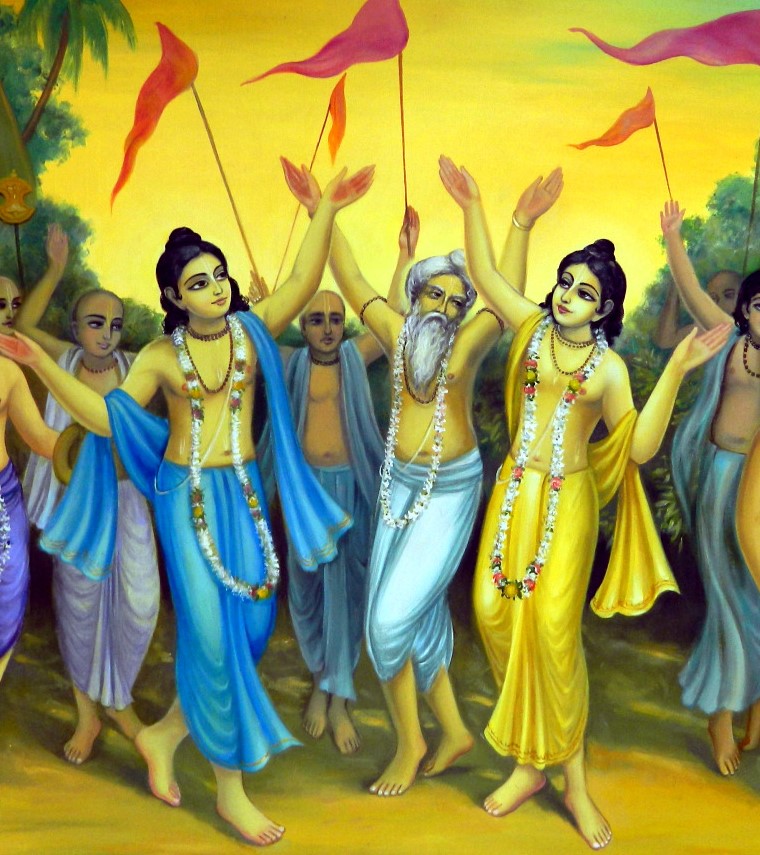
According to the price one pays, one will receive the corresponding commodity. But there is a mystery here: when the customer pays and gets the Holy Name and chants the Holy Name, by the mercy of the owner and His partners, the customer gets back his original payment multiplied many times over.The qualifications for membership are also specified and techniques for chanting are detailed.
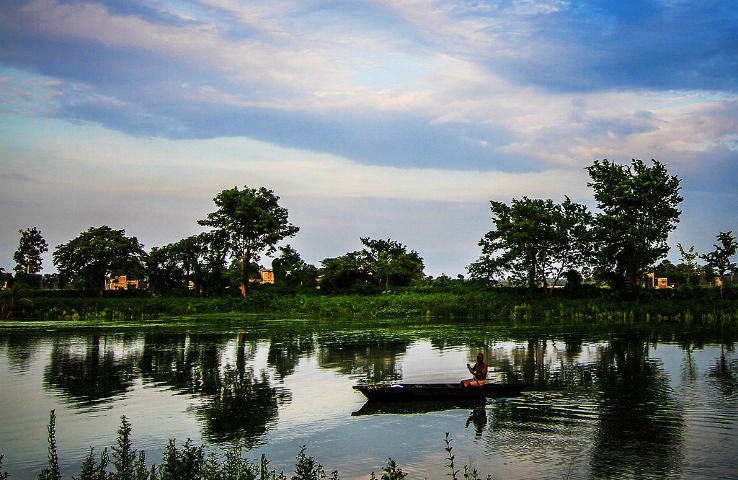
Ghatal
The Thakura then proceeds to describe some of the preaching pastimes of his party of friends:
… the Nama-hatta sweeper, assistant and flag-bearer [Thakur Bhaktivinoda, Bhaktibhrnga Mahasaya and Sitanatha] arrived in the town of Ghatal, Midnapur District, after dark. The devotees escorted the Nama-hatta employees with sanklrtan to the Hari-sabha. More than a thousand devotees of the Nama assembled and engaged in massive sankirtan. The next day at sunrise, along with all the devotees of Ramjivanpur, they performed blissful kirtan and inspected the activities of the Nama-hatta in the prapannasrama [preaching center] of Sriyuta Kunjabihari Paina. More than a thousand devotees assembled, loudly chanting the name of Hari. The Nama-hatta commander for that area, Sriyuta Umacarana Vidyaratna warmly welcomed the sweeper, Bhaktivinoda, his assistant, Bhaktibhrnga, the devotee, Sitanatha, and the assembled Nama-hatta employees. The sweeper, Bhaktivinoda, gave a lecture on the glories of the Holy Name.
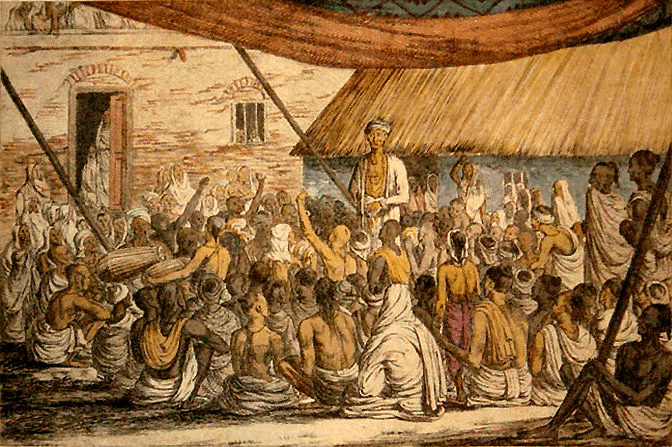
The captivating lecture and Vaisnava songs [I had] personally composed filled the assembled devotees with prema. Travelling salesmen, Sriyuta Ramadasa Babaji and Sriyuta Daracandra Tarkalankara, satisfied the assembly with sweet lectures. The assembly dispersed three hours after darkness had fallen with loud chanting of Hari and pure Nama-sankirtan. [This means the assembly engaged in chanting and hearing all day and into the night!]
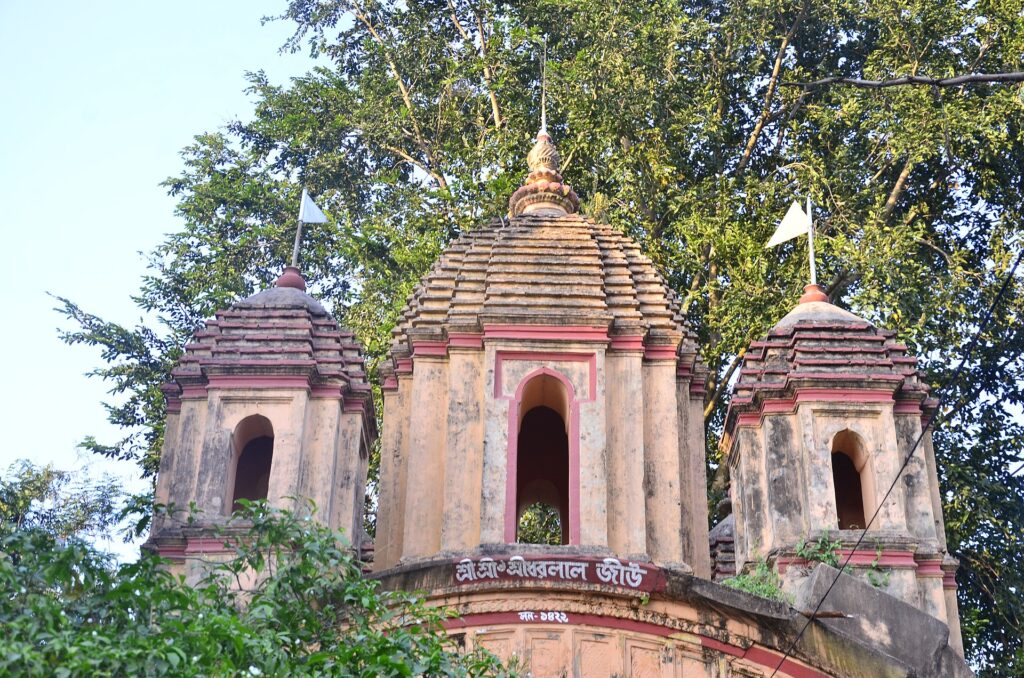
Temple at Ramjivanpur
… at daybreak, street sankirtan went out with a great gathering of Ramjivanpur villagers. The special decorations and mandapas [raised platforms] in front of the houses were a wonderful sight to see. Thereafter, the sankirtan party went on the main road and, coming from their homes, the devotees were chanting the name of Hari in great devotion. At one mandapa, the travelling salesmen [Sriyuta Ramadasa Babaji and Sriyuta Daracandra Tarkalankara] and Bhaktivinoda Thakur explained the glories and the truth of the Name, while from all four sides the village womenfolk raised their voices in ululation. In some places the school children, breaking loose from their teachers’ care, and crying ‘Haribol!’, ran towards the sankirtan party. The devotees were feeling mutual bliss. The minds of everyone present were captured by this enchanting scene …
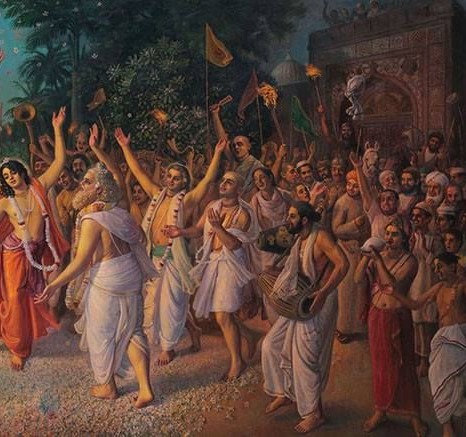
… in a massive gathering at Ramjivanpur, all the Nama-hatta employees did Nama-kirtana from house to house. At the houses of Sriyuta Umes Chandra Modak, Sriyuta Ananta Gayen, Sriyuta Ramachand Datta, Sriyuta Srinivasa Rauth and Sriyuta Ramkalpa Rauth, a great multitude of people received the message of Mahaprabhu. Finally, at the natya-sala [theater] of Sri Parvatinath Mahadeva, nearly two and a half thousand persons came together, where the commander glorified Mahaprabhu from the Vedas and the Puranas. At that time of pure devotional preaching, the sweeper Bhaktivinoda showed the uselessness of the impersonal philosophy. Later, at the prapannasrama of store-keeper Sriyuta Yadunath Pal, the Rasika Mandali performed kirtan.
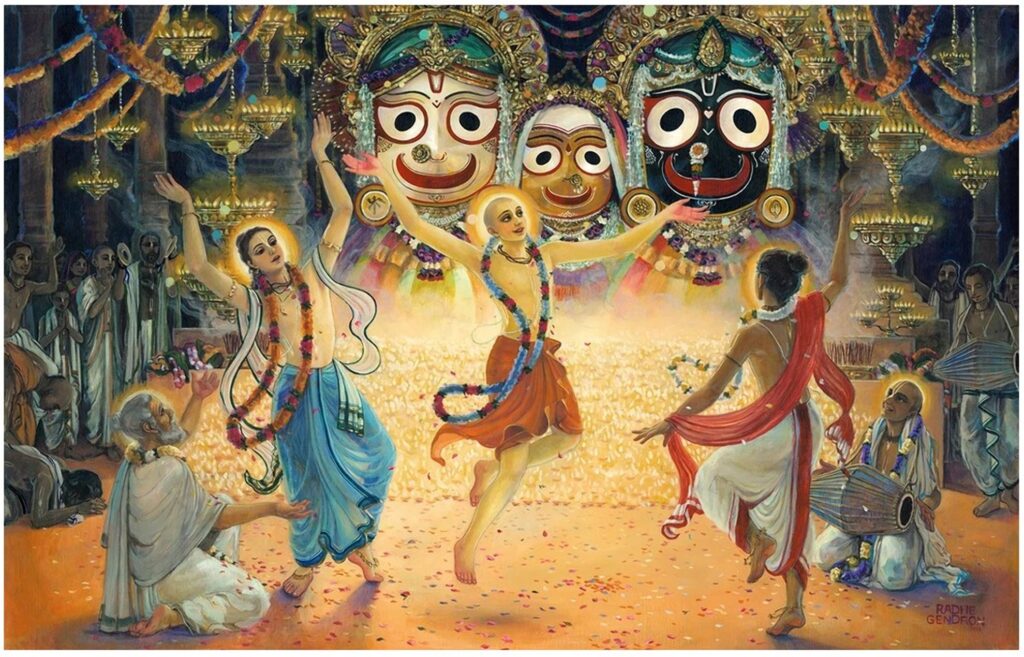
… all the Nama-hatta workers gathered at Hatipur Devakhand, where nearly three-thousand people assembled at the natya-sala of Jagajanani Bhadrakali. The travelling salesmen of that place, Sriyuta Kesava Chandra Chakravarti had made many arrangements with gates and mandapas. The villagers took the Nama-hatta workers with great enthusiasm from the bank of the river to a pandal [pavilion-tent]. Along the way, village women, filled with ecstasy, were ululating [an ancient practice which is supposed to generate auspiciousness and lauds heroic enterprises]. Those present will not forget the enchanting scene. At that time everyone lost material consciousness, submerged in the ocean of Krishna-prema.
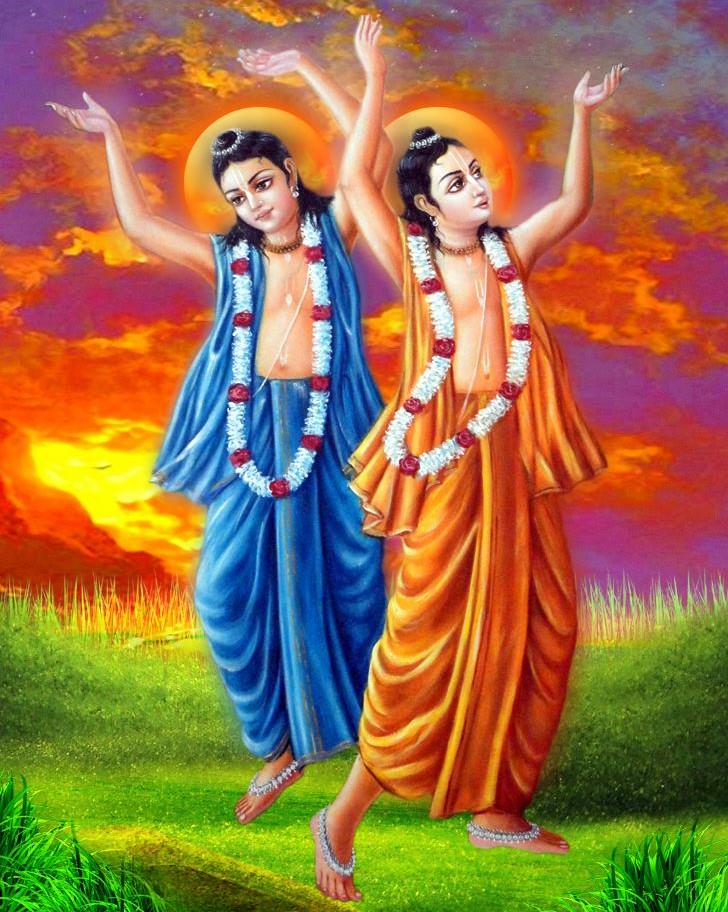
After all the devotees were properly seated on the mandapa, the following song was sung:
Nityananda has come to the Marketplace of the Name. Whoever is coming, run quickly. Those two rascals Jagai and Madhai have looted the storehouse and taken all the goods. You will find the partners Advaita and Sanatan are the storehouse managers. Gadadhar Pandit is the guard. Haridas is the watchman. Sanjaya and Sridhar are the bearers. Kesava Bharati and Vidyavacaspati are brokers, and Krishnadas and others are managers. Srivas Pandit is the treasurer, and Kedaranatha [Bhaktivinoda] is the sweeper. The cost of the goods in the store are the nine kinds of devotional service. The gold coin is prema. There is no limit. With whatever you have got, buy what you can. There is no shortage, brothers, take as much of the goods as you can. For obtaining love of God, this is the best advice. The message is the nectarean name of the Lord, so let there be no useless strife. Let everyone, whoever he may be, share the same plate.
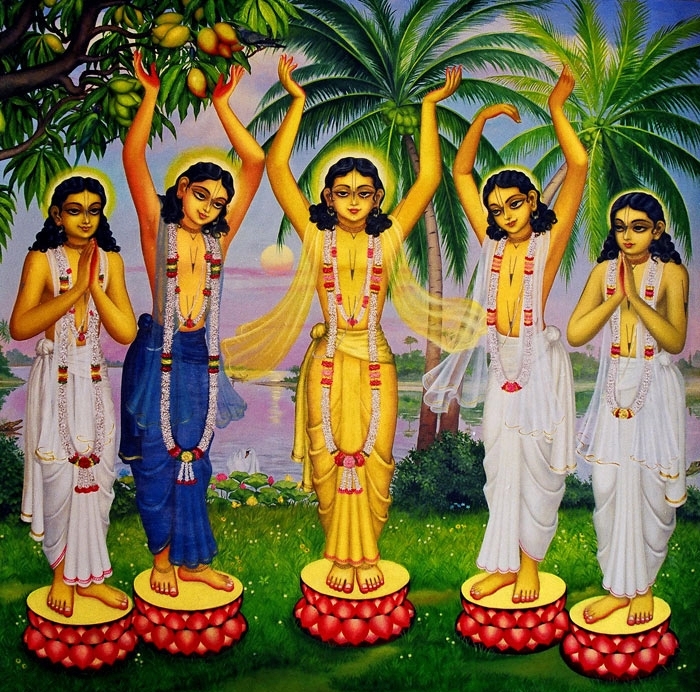
… Nama-hatta workers assembled at Bhaktinidhi’s Vadan Ganj prapannasrama in the morning. Later at Koyapat Bazaar, nearly four-thousand people came to see the Nama-hatta workers. The first few minutes were spent in getting the people to be quiet. Bhaktinidhi’s lecture was followed by a lecture by Bhaktivinoda on the verse ‘vadanti tat tattva-vidas tattvam …’ from Srimad-Bhagavatam (1:2:11):
(Learned transcendentalists who know the Absolute Truth call this nondual substance Brahman, Paramatma or Bhagavan.)
With this verse he destroyed the impersonalist philosophy and established the truth of pure devotion to Bhagavan Sri Krishna … During all of these lectures the listeners’ hearts were filled with devotional ecstasy, exhibited by frequent applause and crying of ‘Hari!’ with love-filled enthusiasm.
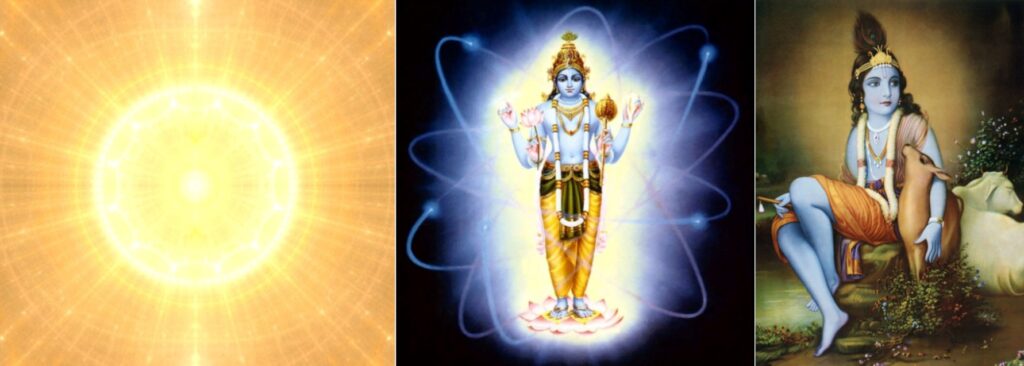
Brahman, Paramatma and Bhagavan
In these wonderful excerpts we catch a glimpse of the jubilant preaching exploits of Srila Bhaktivinoda Thakur. His activities immediately invoke the original preaching mood of Lord Chaitanya and Lord Nityananda, on account of which huge crowds wildly chanted the Holy Name in ecstasy, due to the mercy of the eternally liberated associate of the Lord, Srila Bhaktivinoda Thakur.

Gateway to Krishnanagar
In February of 1892, the Thakur was invited to speak at Krishnanagar before a large congregation of highly learned men from various parts of Bengal. He gave a lecture concerning his investigation and research into the genuine site of Lord Chaitanya’s birth. After hearing his powerful presentation, the members of the assembly, who were overwhelmingly impressed by the Thakur’s work, pledged their help by agreeing to join a society organized by the Thakur for the restoration, maintenance and development of Old Navadvipa at Sri Mayapur, called Sri Navadvipa-Dhama-Pracarini-Sabha. The Thakur made the ruling princes of Tipperah the society’s hereditary presidents. Europeans were also present at the meeting, and the Thakur recalls the names: Monroe, Wallace and Butler. The Thakur also lectured to other societies and assemblies in the Krishnanagar area.
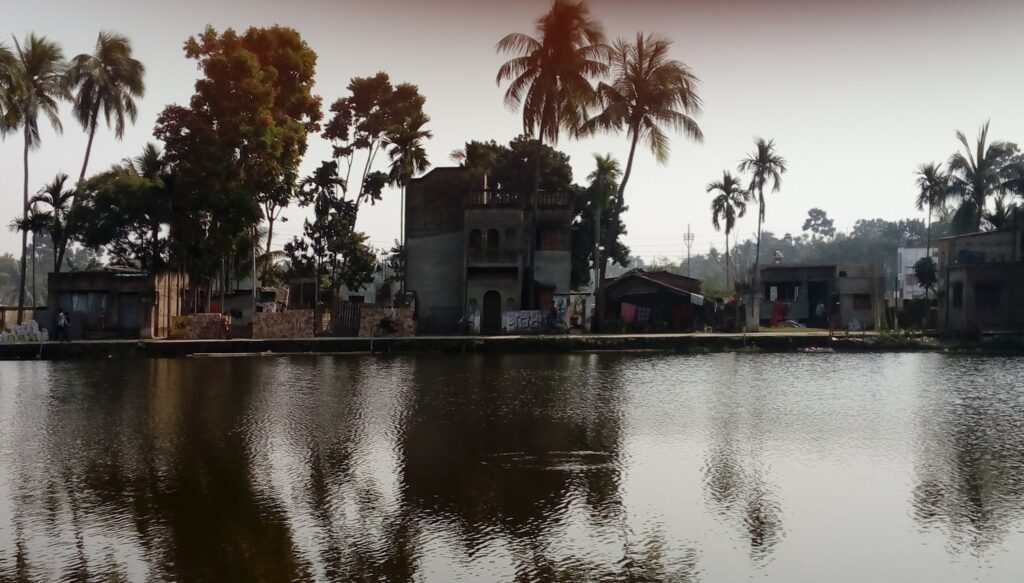
Navadvipa
In March of 1892, accompanied by his Vaisnava friends, the Thakur made a lecture tour of the Basirhat sub-division, located in the north-eastern part of West Bengal’s Cabbisa Pargana district. He was preaching, chanting and writing constantly during this period. His influence was tremendous. He opened a good number of branches of Nama-hatta, and everywhere people began to take up the chanting of the Holy Name. This program was so successful and popular that even after the Thakur ceased his participation, due to the call of government duties, it continued for many years. After the Basirhat tour, the Thakur took his friend Bhaktibhrnga Mahasaya with him for a tour of Vrindavan.
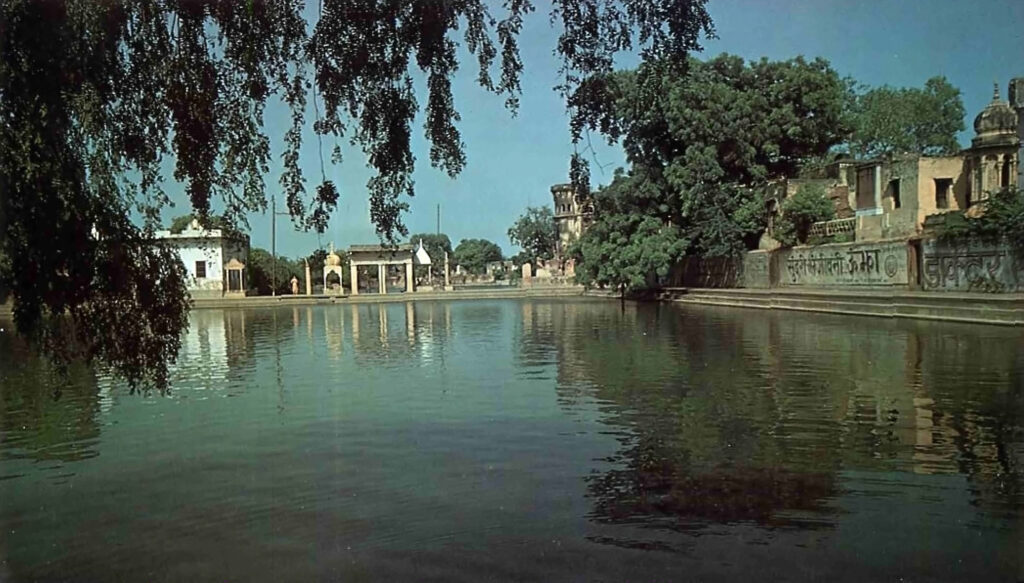
Radha-kunda: Radharani’s bathing pool
On the way they spent the Ekadasi fast day with Srila Jagannath Das Babaji Maharaja. The Thakur reached Vrindavan in great ecstasy and undertook a full tour of the Dhama, visiting Bilvavana, Bhandiravana, Manasa-sarovara, Gokula, Madhuvana, Talavana, Bahulavana, Govardhana, Radha-kunda, Syama-kunda – in short, all the main places of Krishna’s transcendental pastimes.
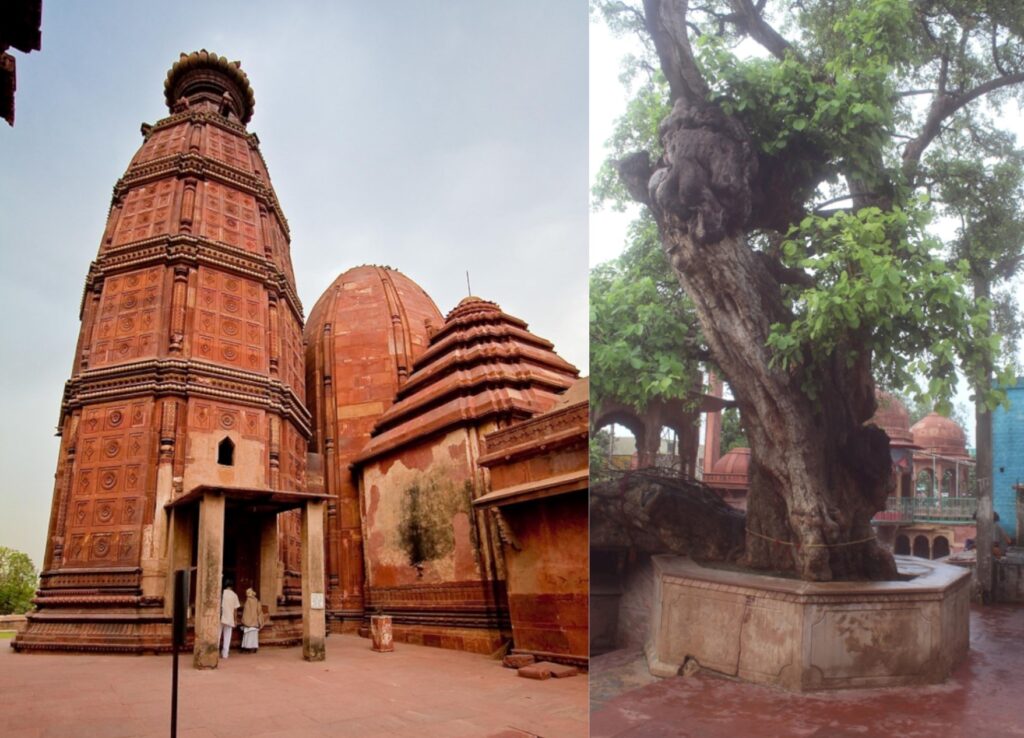
Madan Mohan Temple and the Kadamba Tree at Kaliya Ghat from which Krishna jumped into the Jamuna River to subdue the Kaliya Serpent
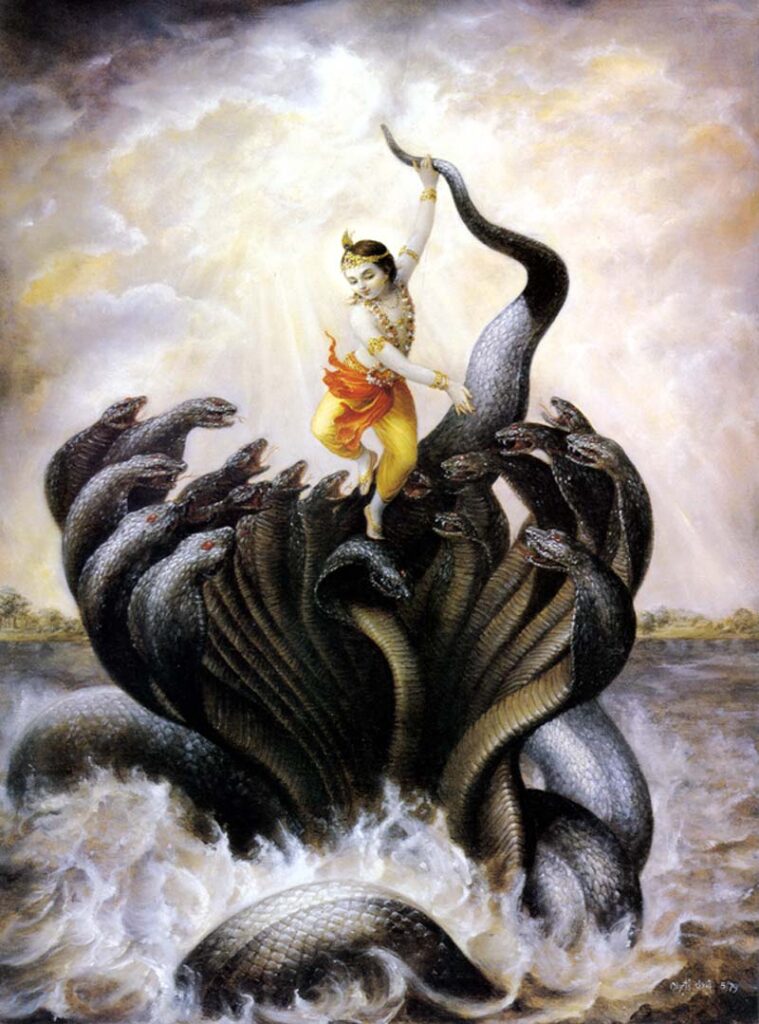
Upon returning to his Bhakti Bhavan in Calcutta, he continued his preaching activities, giving lectures and readings about the glories of the Holy Name. Sometimes he was in Godruma, sometimes in Calcutta and sometimes in Krishnanagar.
A Time of Prolific Writing and Publishing
During the time of his two-year preaching furlough, the Thakur produced another huge literary outpouring. In 1892, he published short excerpts in pamphlet form of an earlier published work called Vaisnava-siddhanta-mala. The pamphlets were based mainly on the portion of the book which deals with the glories of the Holy Name. These were distributed to the people as part of the Thakur’s Nama-hatta program, and were very well received. Also in 1892, the Thakura published a book called Sriman Mahaprabhur Siksa, a book of eleven chapters, summarizing Lord Chaitanya’s philosophy in ten major categories. The work features many important Sanskrit quotations to substantiate each point, as well as Bengali prose translations and explanations.
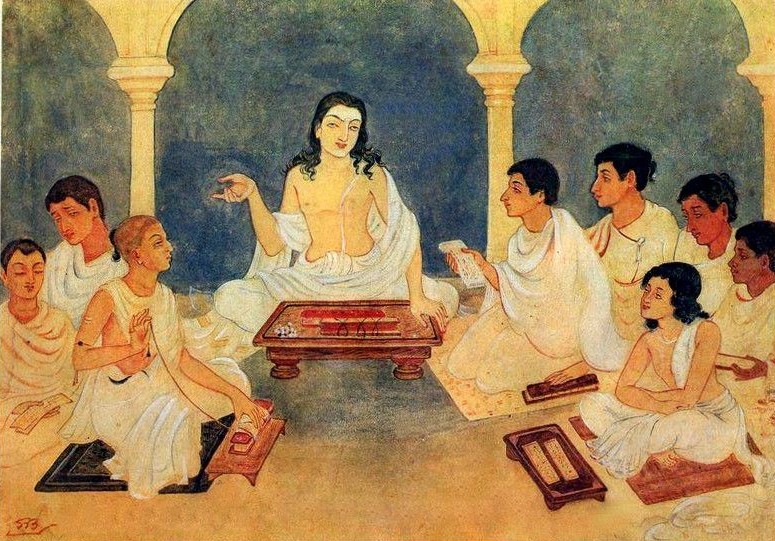
But in 1893, the real deluge occurred. He wrote Tattva-viveka or Sac-cid-anandanubhuti, which was a presentation of the teachings of the greatest Vaisnava acaryas in relation to the ideas of famous Western and Oriental philosophers. The book comprised forty-eight Sanskrit verses with detailed Bengali commentary on each verse. Then came the beautiful and inspiring Saranagati, Gita-mala and Gitavali – three songbooks which perfectly expressed in simple Bengali the philosophy of Krishna consciousness and the lofty realizations and sentiments of a self-realized soul.
Following are a few excerpts from the ‘Atma Nivedana’ section of Saranagati. The original songs are written in beautiful Bengali prose. The Thakur’s amazing wisdom, humility and surrender to the Lord are not lost in the English translations:
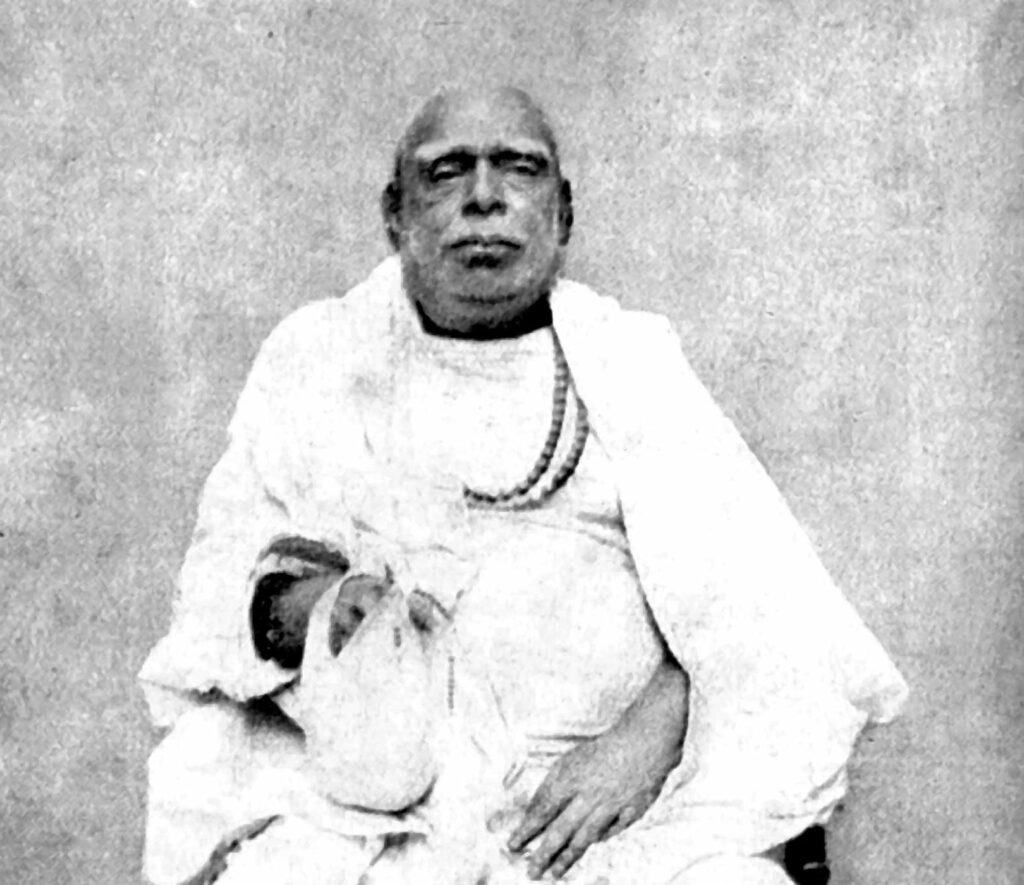
How much more shall I tell You of my shameful story? There is no sin which I have not committed thousands and thousands of times. My life in this world has been one of affliction and torment as a result of those sins. Whom will I blame but myself? At the time I did not consider the consequences; now, in the aftermath, I seek to be saved. After judging my sins, You should punish me, for I deserve to suffer the pangs of rebirth in this world. I only pray that, as I wander through repeated births and deaths, my mind may ever dwell at Your lotus feet in the company of Vaisnavas. I offer You this judicious prayer. My heart’s false pride has gone far away. O You who are so kind to the meek, Your pure mercy has become Bhaktivinoda’s only hope.
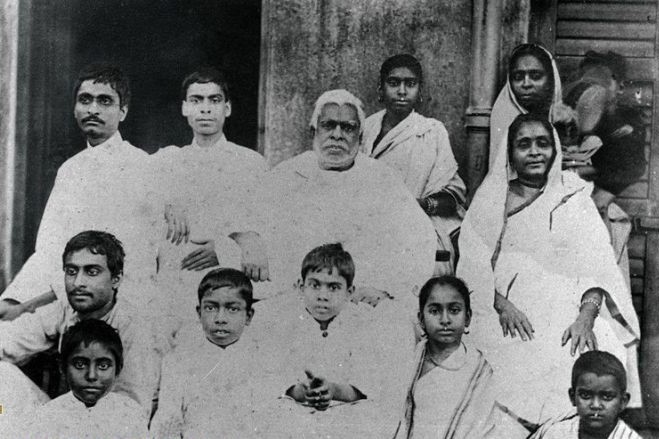
Mind, body, and family, whatever may be mine, I have surrendered at Your lotus feet, O youthful son of Nanda! In good fortune or in bad, in life or at death, all my difficulties have disappeared by choosing those feet of Yours as my only shelter. Slay me or protect me as You wish, for You are the master of Your eternal servant. If it is Your will that I be born again, then may it be in the home of Your devotee. May I be born again even as a worm, so long as I may remain Your devotee. I have no desire to be born as a Brahma averse to You. I yearn for the company of that devotee who is completely devoid of all desire for worldly enjoyment or liberation. Father, mother, lover, son, Lord, preceptor, and husband; You are everything to me. Thakura Bhaktivinoda says, “O Kana, please hear me! O Lord of Radha, You are my life and soul!”
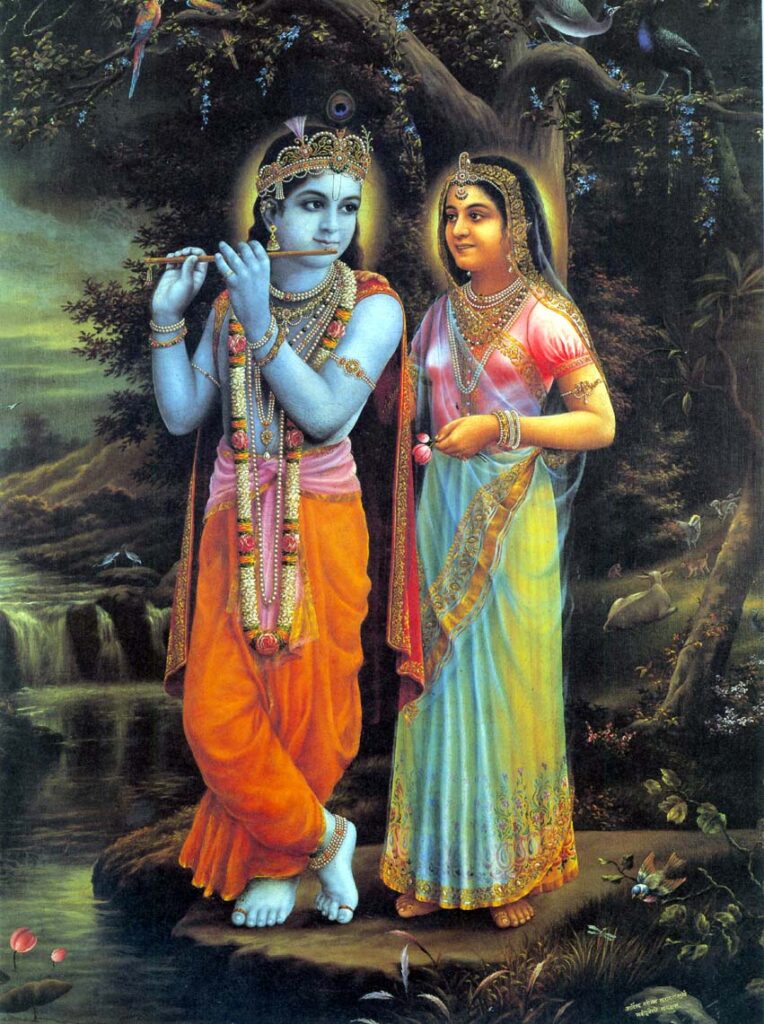
Whatever I am, whatever I possess, I offer at Your lotus feet, O merciful Lord. I no longer belong to myself. Now I am exclusively Yours. The soul inhabiting this mortal body has given up the false ego attached to the word “I”, and now the eternal, spiritual sense of being Yours has entered his heart. All my possessions – body, brothers, friends, and followers, wife, sons, personal belongings, house and home – all of these I give You, for I have become Your servant. Now I dwell in Your house. You are the Lord of my house, and I Your most obedient servant. Your happiness is my only endeavor now. Whatever piety or sins were done by me, by mind or deed, are no longer mine, for I am redeemed. My desire has become one with Yours. From this day Bhaktivinoda has no other identity.
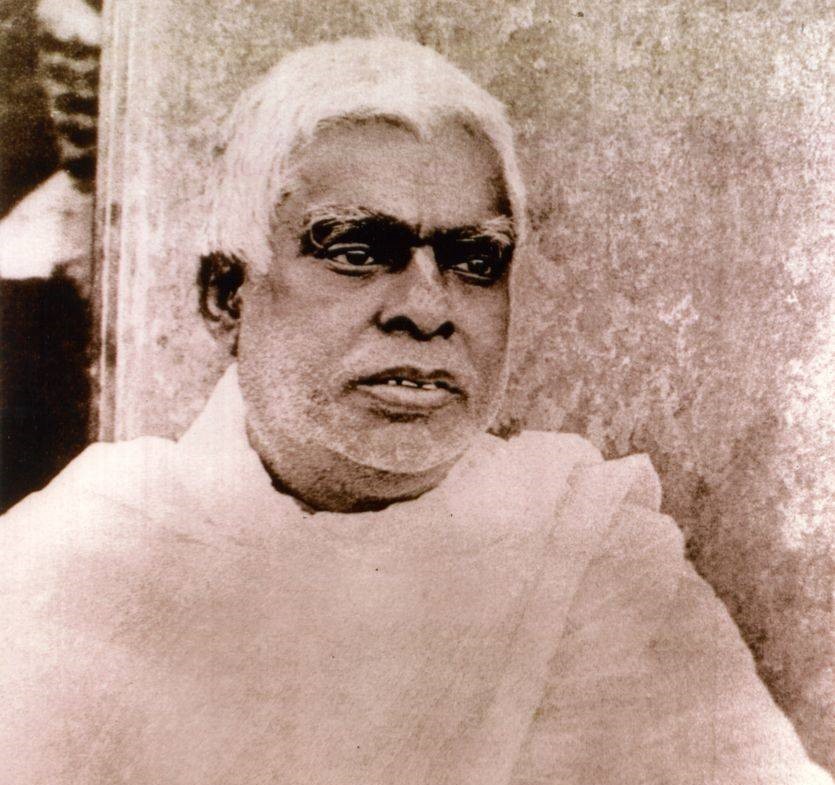
In truth, all things belong to You. No jiva is owner of anything. The tiny soul wanders in this world mistakenly thinking, “I am this transitory body, and everything related to this body is mine.” Thus he suffers sorrow and fear. The conditioned soul is falsely proud and considers everything attached to the words “I” and “mine” to be his treasures alone. Due to that same vanity, I fell into this world. Floundering in the ocean of mundane existence like a drowning man, I suffer the pangs of rising and sinking in that ocean. I take shelter at Your lotus feet, which award fearlessness, and dedicate myself to You on this day. The vanity of “I” and “mine” has left me now. May it never again find a place within my heart. O Lord, please give me this strength, that I may be able to keep the false conceptions of “I” and “Mine” far away. May the mood of self-surrender to the Supreme Lord remain firmly fixed in my heart and not prove to be like the momentary cleanliness of an elephant after a bath. Bhaktivinoda begs at the lotus feet of Lord Nityananda for the grace which delivers one from all false pride.
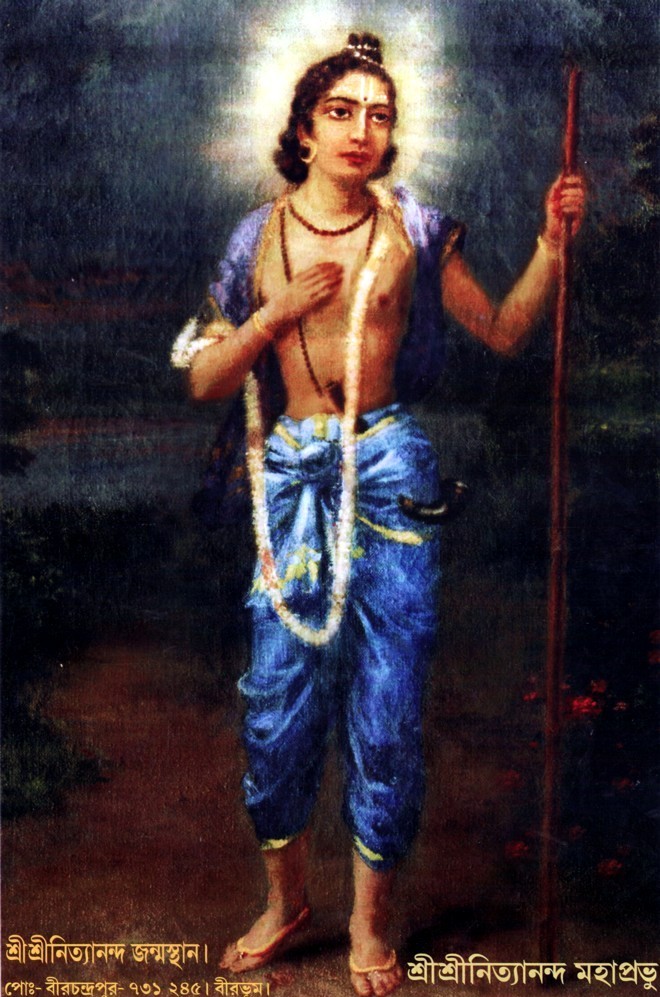
Also in 1893, Srila Thakur Bhaktivinoda wrote a Sanskrit poem about Lord Chaitanya called Sri Godruma-candra-bhajanopadesa, two more songbooks, entitled Baula-sarigita and Dalaler-gita, and a booklet in English entitled Nama-bhajana, about the Holy Name of Krishna. He also wrote a monumental novel called Jaiva Dharma which was a wonderful overview of Gaudiya Vaisnava thought and answered just about any question that an inquisitive and intelligent seeker could ever think to ask. He also wrote Tattva-sutram, a book of Sanskrit aphorisms with Sanskrit explanations and Bengali commentary. He thus produced ten significant works – one of them of major proportions – all in one year! And meanwhile he was lecturing, chanting and preaching to whomever he met.
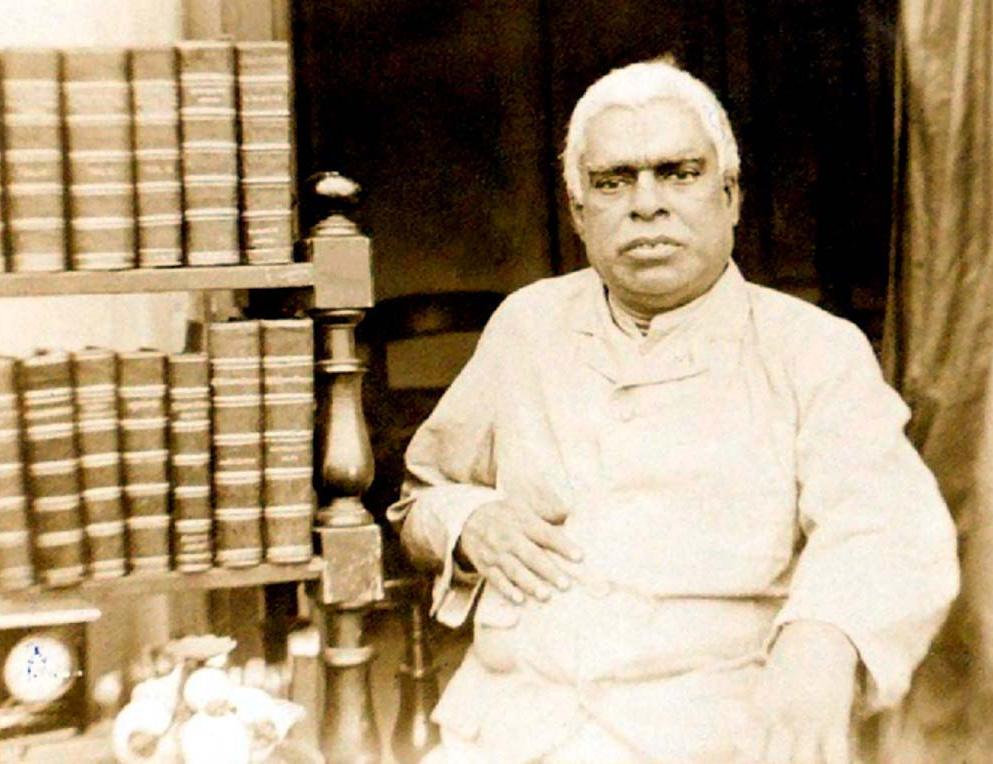
We can begin to understand from all this holy activity what gaura-sakti-svarupa really means. Srila Bhaktivinoda Thakur truly was the embodiment of the transcendental energy of Lord Chaitanya, for these are not the activities of anyone but an empowered associate of the Lord. In a similar fashion, His Divine Grace A. C. Bhaktivedanta Swami Prabhupad presented seventeen volumes of Sri Caitanya-caritamrta, with full commentary in English, in eighteen months, while spreading Krishna consciousness all over the world. Srila Bhaktivedanta Swami himself described such work as “materially impossible,” and this certainly also applies to the super-human literary output of Srila Bhaktivinoda Thakur.
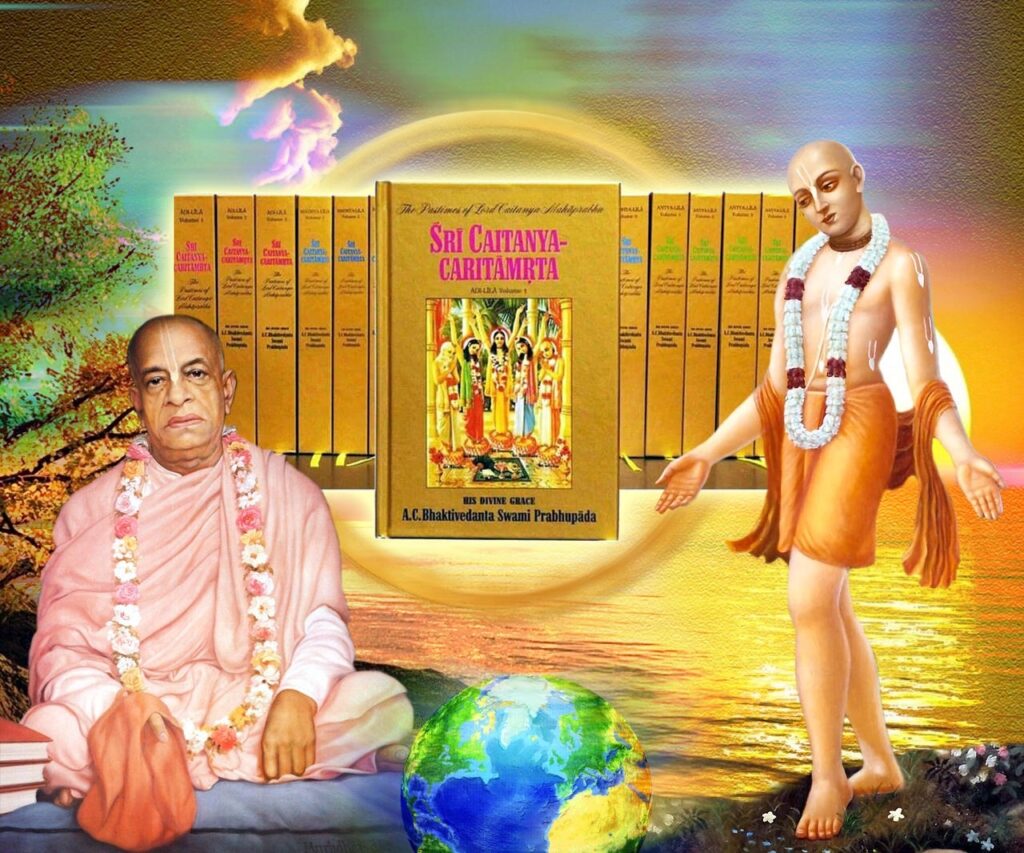
To get some idea of the flavor of his writings during this period we turn to the song Dalaler-gita (‘The Song of the Broker’) in which he glorifies the Holy Name and the mercy of Lord Nityananda – as was his constant practice in preaching to the masses. He was always either chanting the Holy Name or speaking on the chanting of the Holy Name, and we get some clear idea of the level of inspiration and spiritual enthusiasm he was experiencing during this period from the moving poetic excerpts which follow.
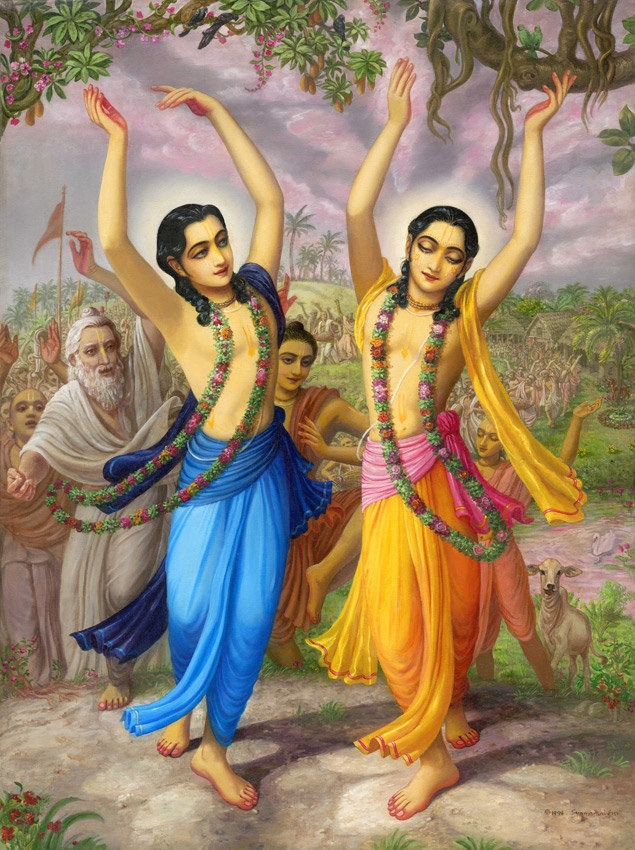
Dalaler-gita (‘The Song of the Broker’)
[1] I am singing the news of the greatest happy tidings! At the place known as Surabhi-kunja in Sri Navadvipa, a marketplace of the Holy Name has now been opened – and Lord Nityananda Himself is the Proprietor-in-Chief.
[2] Such wonderful things are going on in that blissful marketplace! Sri Nityananda Prabhu is selling the pure, unadulterated Holy Name wholesale, merely for the price of one’s faith.
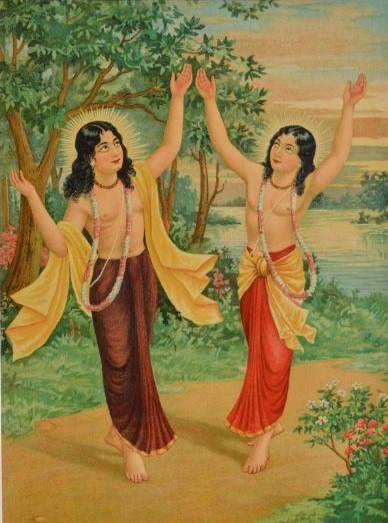
[3] Seeing the assembly of devotees eagerly waiting to purchase the Name, Lord Nityananda examines them all, one by one, to test the degree of their receptivity – and then He sells them the Name individually by bargaining for His price accordingly.
[4] Oh brother, my dear friend! If you really want to purchase this pure Holy Name, then come! Just come with me, for I am now going to meet with that very same Nityananda Mahajana.
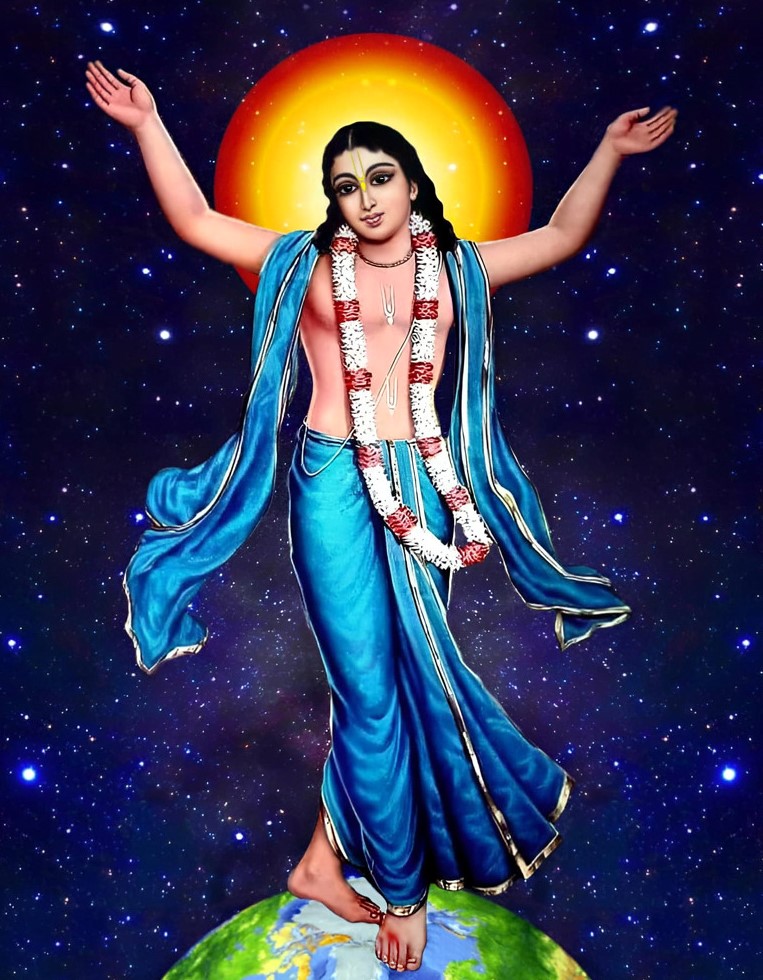
[5] Thus, you will finally be able to purchase the pure Holy Name. I will also take my due commission, and in this way all three of us will fulfill our desires.
[6] Sri Nityananda Prabhu is so incredibly merciful. Taking only one’s faith in the Holy Name, He bestows the topmost divine bliss in exchange.
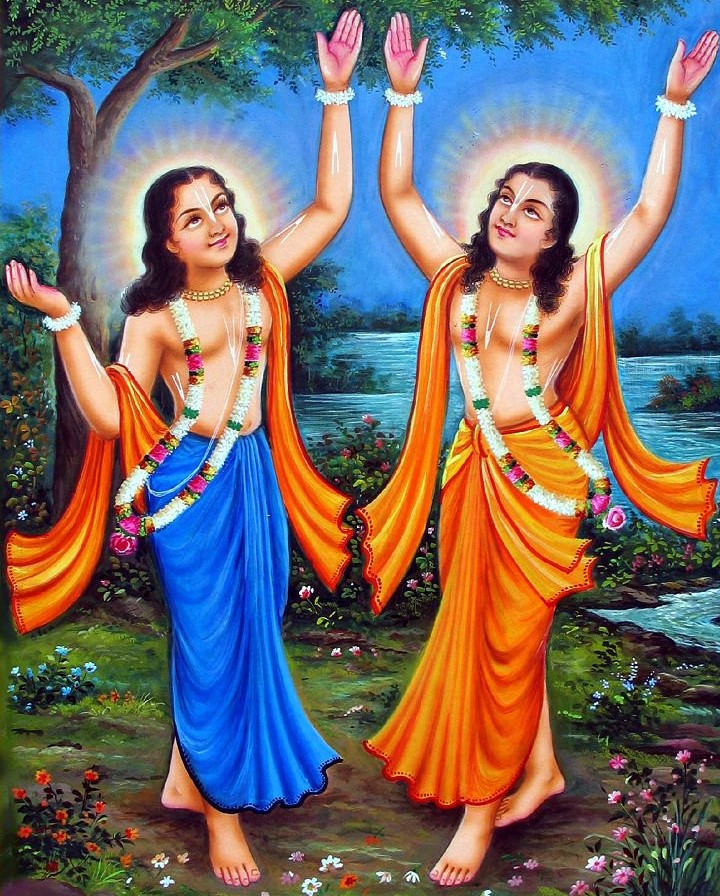
[7] The very second that Nitai sees a tear welling in someone’s eye upon chanting the name of ‘Gaura,’ He instantly gives His support to that person; indeed, He bestows all divine opulences upon him.
[8] He gives that person genuine realization of the pure teachings of Sri Krishna as found in the Bhagavad-gita and Srimad-Bhagavatam. While giving all this inconceivable mercy, He never cares in the least for one’s position in relation to caste, material wealth, mundane knowledge or physical ability.
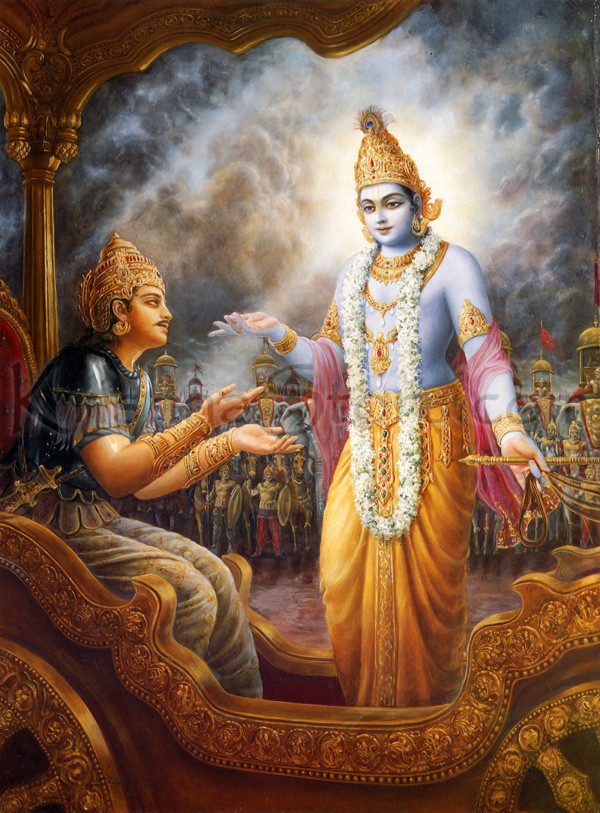
[9] Now, dear brothers, just reject the illusory network of Maya’s entangling snares. If you are a householder, then just remain at your home, if you are renounced, then just live peacefully in the forest – either way, you will experience no more misery.
[10] Now there is no more fear of the terrible Age of Quarrel, for the most merciful Lord Nityananda gives the Holy Name to anyone and everyone – even the lowest among men.
[11] Bhaktivinoda loudly calls out and advises all, “Except for the lotus feet of Lord Nityananda, there is no other shelter!”
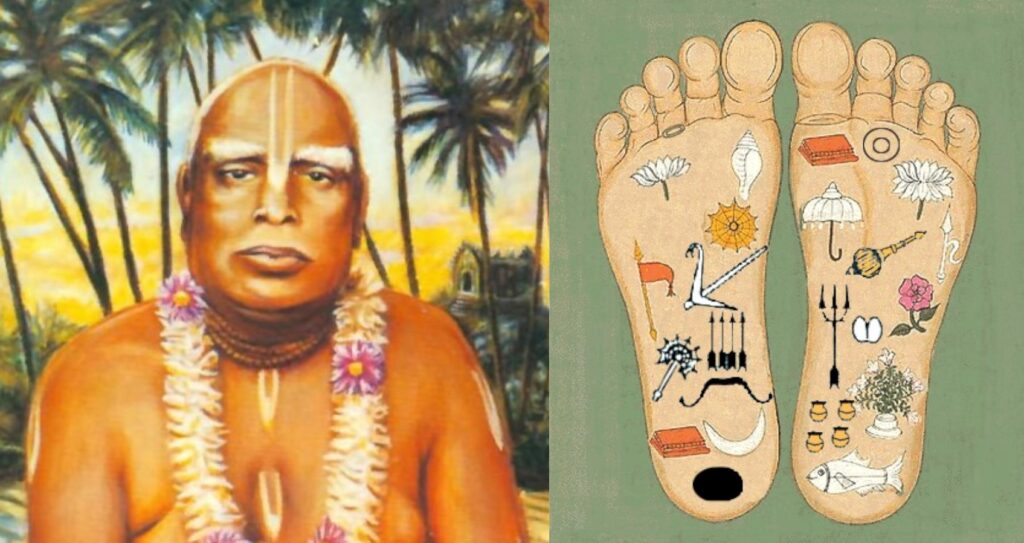
In 1893, in the midst of his expansive preaching activity, the Thakur also had the good fortune of getting the association of Srila Jagannath Das Babaji who, accompanied by many Vaisnavas, came to Sri Mayapur on pilgrimage and visited the Thakur at Godruma.
Sri Navadvipa Dham was made by Srimati Radharani as an offering to Lord Krishna. Krishna asked all the holy places to come to reside in Navadvipa Dham and they came. Navadvipa Dham is non-different from Vrindavan. It is called Audharya dham, the ‘land of mercy.’ Here, devotees can easily be granted mercy to awaken their dormant love of Krishna. When advanced devotees visit Navadvipa, they not only see the pastime places of Lord Chaitanya and Lord Nityananda, but also different holy places associated with Lord Krishna and His different incarnations.
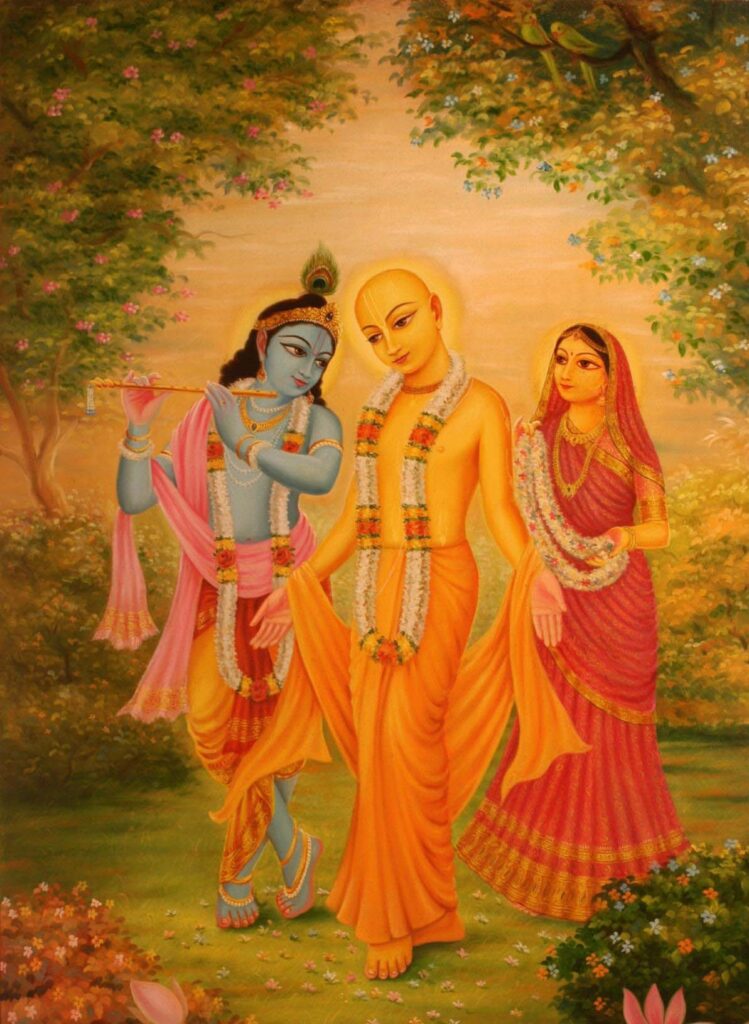
The various areas of Navadvipa correspond with their spititual counterparts in Vrindavan, and self-realized devotees like Srila Bhaktivinoda Thakur can experience the pastimes of Lord Chaitanya and the corresponding pastimes of Krishna in the Holy Dham. Godrumadvipa, where Srila Bhaktivinoda Thakur had his place of worship, Sri Surabhi Kunja, corresponds to Nandagram in Vrindavan, where Krishna lives in the palace of Nanda Maharaja.
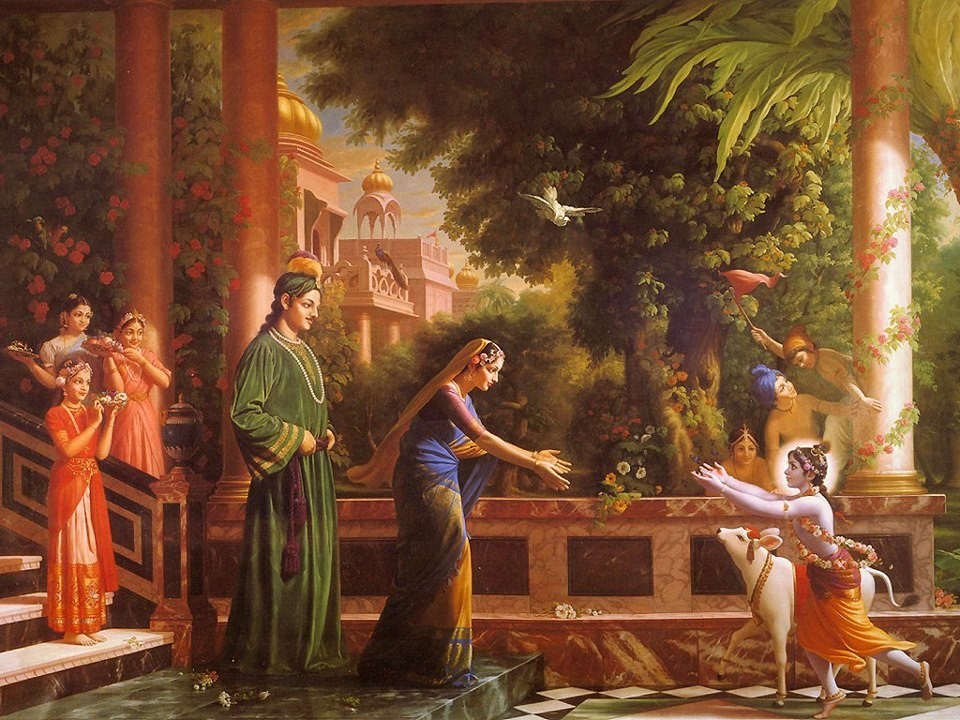
Srila Bhaktivinoda Thakur wrote some beautiful songs which touch on the inner reality of Godruma, as experienced by the great Vaisnava saint. In his Saranagati, we find two verses in glorification of Godruma, both in ‘Bhajana Lalasa’, Songs 10 and 13:
Gurudeva! Because you are so merciful, you gave me a place in Godruma amid the woodlands of Gauda, with this order to fulfill: “Dwell here in this Vrndavan and sing the holy name of Hari.”
Gurudeva! Lord Gauranga’s transcendental pastimes are eternal realities. I await the day when, with this firm faith manifested by your mercy, I will wander through the groves of Godruma, chanting “Hari! Hari!” and hoping to behold those pastimes.
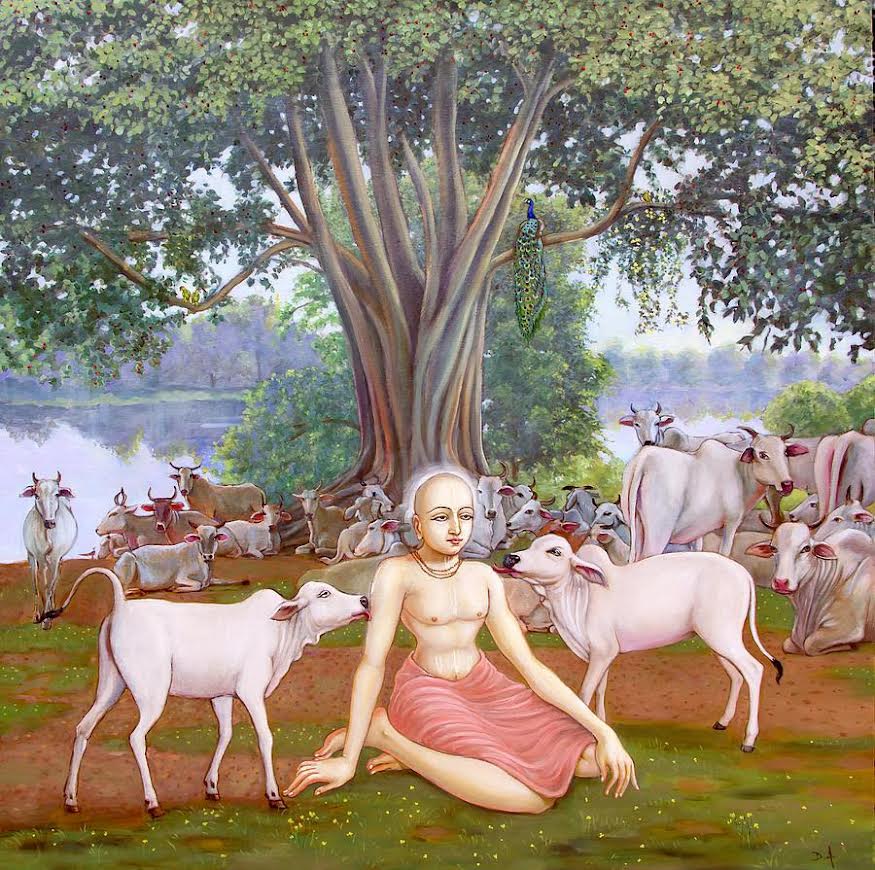
Lord Chaitanya in Vrindavan
From Sri Godrumacandra-bhajanopadesha [‘Instructions to Worship the Moon of Godruma‘] I have selected the translations of a few verses:
Krishna, the transcendental paramour, stands on the banks of the Yamuna with Radha, the daughter of Vrsabhanu, on His left side. He is absorbed in the pastime of playing soft, melodious songs on His flute. Just worship Lord Gaura, the moon of Godruma’s forest bowers, Lord Chaitanya, who is non-different from the son of Nanda.
He is Lord Hari, shining like molten gold and surrounded by His loving devotees in the midst of hari-kirtan, He is the only ocean of mercy for the Gaudiya Vaisnavas. Just worship Lord Gaura, the moon of Godruma’s forest bowers.
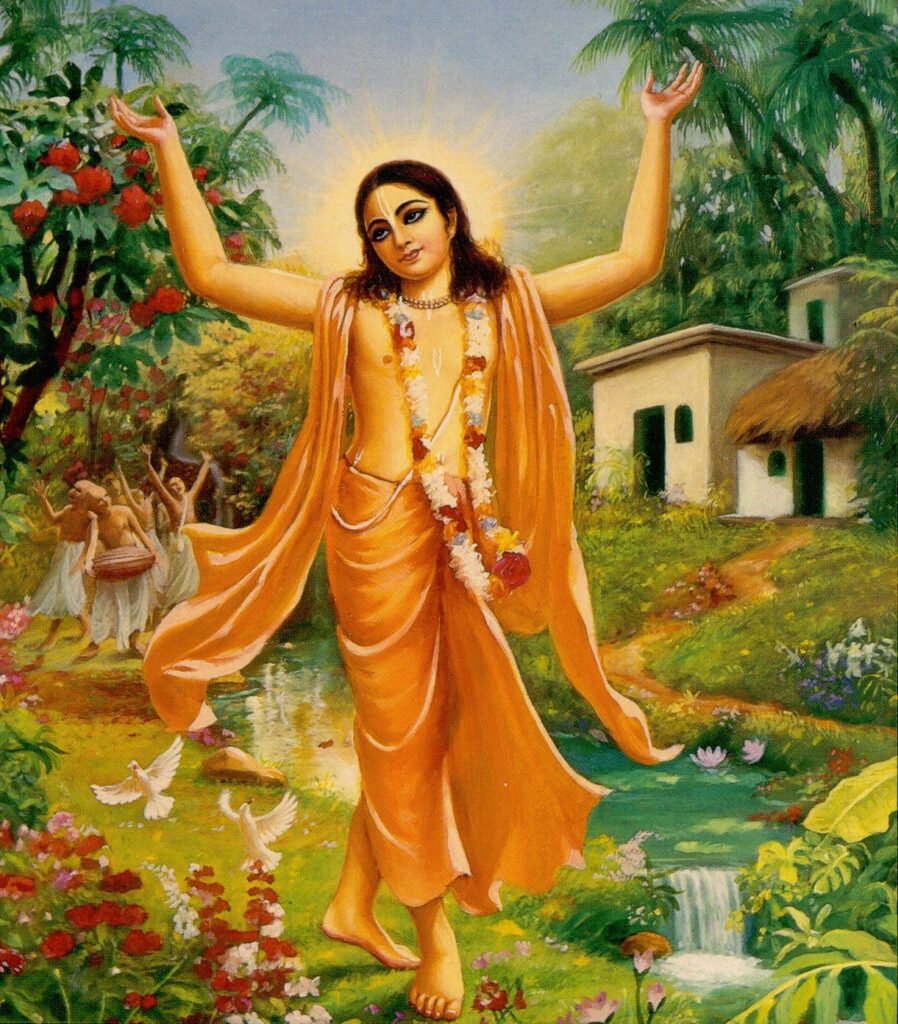
Lord Gauranga is like a powerful hammer smashing the sin and oppression of the mad-dog of the Kali-yuga. And He is absorbed in distributing the holy name of Krishna, which is the greatest medicine to release one from material existence. His transcendental form is beautiful , and His heart is full of compassion for the suffering, fallen souls of this world. Just worship Lord Gaura, the moon of Godruma’s forest bowers.
Remaining devoted to the service of the Vaisnavas, being addicted to drinking the sweet nectar of the name of Hari, and with a mentality endowed with modesty, humility, and compassion, just worship Lord Gaura, the moon of Godruma’s forest bowers.
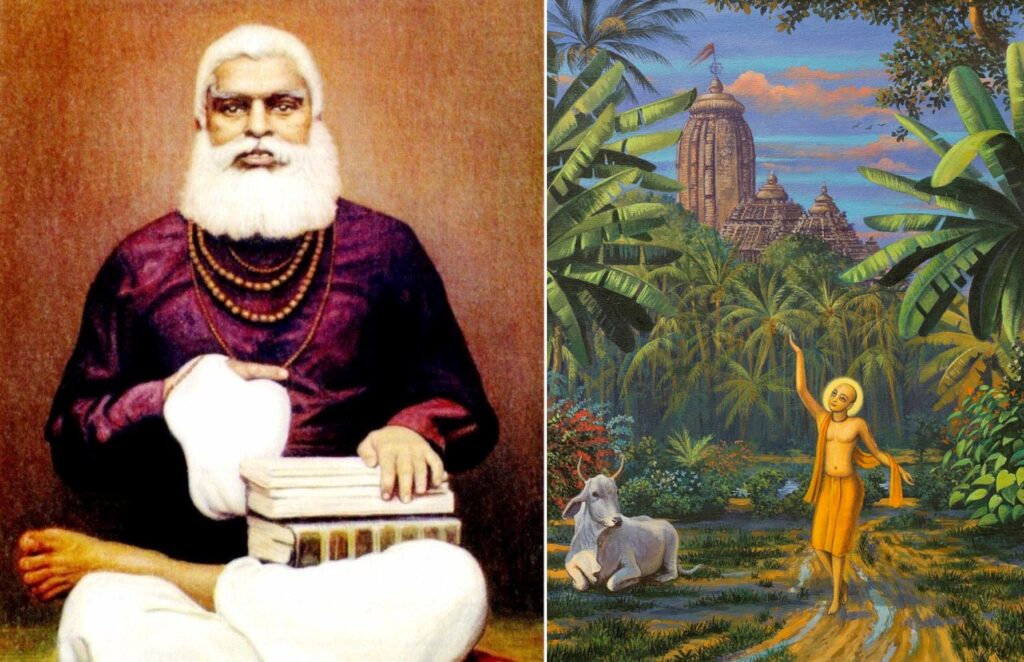
Just worship Lord Gaura, the moon of Godruma’s forest bowers and call out to the Lord “O Lord of the Vrindavan forest, which lies along the banks of the Yamuna! O Lord of Govardhana Hill! O sun of the forest of Gokula! O giver of life to the rasa dance! O Gaurahari!“
Go to Navadvipa, the land of Lord Chaitanya. Read and recite with great joy the wonderful pastimes of Lord Gaurahari. Roll about in ecstasy on the banks of the Ganges, which are marked with the footprints of Lord Chaitanya, and just worship Lord Gaura, the moon of Godruma’s forest bowers. Remember the wonderful pastimes of Gaura and Gadadhara.
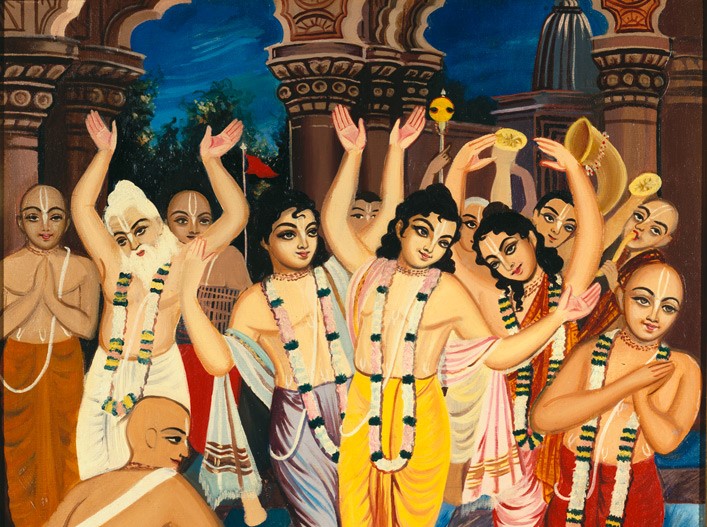

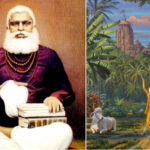
Leave A Reply